#one is partly derived from the concept art
Explore tagged Tumblr posts
Text



some dragon rainbows :]c
#canid's art#dragon gem au#rainbow quartz 2.0#steven universe#one is partly derived from the concept art#i might edit the ref to include the scarf bc holy shit
8 notes
·
View notes
Note
as someone who isn't into zdarsky's run, i mostly agree with your points about why people don't care for it, and i think that the comparison with ram v's current run holds a lot of insight into why i feel it falls flat on a lot of points. ram v's run has also sidelined most of the batfamily, it's also drawing on Batman R.I.P. with its use of Dr. Hurt, its choice of cast and use of b-plots feels very NML… but i like what ram v's run has to say about batman through the lens of cassbats vs azbats, and the prose + artwork + pacing is excellent so i enjoy reading it even when i think it's getting a little caught up in morrison thoughts. meanwhile zdarsky's run is tripped up by a lot of weird event pacing in a way i think is very similar to fear state and keeps overtly reminding me of other stories with art styles and theses about batman that i like more.
I have no problem with people liking one run more than another: honestly I think it's healthy and good marketing to have runs catering to different segments of the fandom. There are occasional glorious periods where it feels like everyone is getting fed, but most of the time, what most fans realistically want is to pick up a title that they are enjoying and not want to throw it across the room.
I...don't expect every run I read to be glorious. I hope it's steady, competent writing with something for me to enjoy in it. And that's what I'm largely getting from Zdarsky. I do think it's a run that helps to have a fair amount of back history on, in that Zdarsky loves a reference, but one of the things I actually really enjoy in comics is the way stories layer on top of each other and become more interesting and complex via those layers, even if any one story may not be 'brilliant', or it might seem derivative pointing to a better written earlier story.
Zdarsky's use of ZEA feels so much clearer in terms of shaping how the concept works than say Batman RIP. And I've got a soft spot for all the Brother-Eye and OMAC references going on, and for Bruce being a freak with a memory palace who's inflicted all sorts of experimental psychological experiments on himself over the years in the pursuit of being BETTER. ZEA as a concept is about things Bruce has done to himself, while Barbatos is something external that is fascinated with Bruce.
I suspect I'm really going to enjoy Ram V's 'Tec run, especially as from all accounts he's got a very structured plot and is being allowed the space to tell it (something I'm fond of), but given I'm currently also on my long range read of Batbooks in order I'm actually trying not to be across current Bat books too much so I can keep everything organised in my head. I'm reading Batman partly because it's Tim's current book and partly because it's where the narrative is revolving at the moment, meaning I can discuss it with other people.
8 notes
·
View notes
Text
Thinking In The Extraverted Attitude
As a result of the general attitude of extraversion, thinking is orientated by the object and objective data. This orientation of thinking produces a noticeable peculiarity.
As a result of the general attitude of extraversion, thinking is orientated by the object and objective data. This orientation of thinking produces a noticeable peculiarity.
Extraverted thinking is conditioned in a larger measure by these latter factors than by the former. judgment always presupposes a criterion ; for the extraverted judgment, the valid and determining criterion is the standard taken from objective conditions, no matter whether this be directly represented by an objectively perceptible fact, or expressed in an objective idea ; for an objective idea, even when subjectively sanctioned, is equally external and objective in origin. Extraverted thinking, therefore, need not necessarily be a merely concretistic thinking it may equally well be a purely ideal thinking, if, for instance, it can be shown that the ideas with which it is engaged are to a great extent borrowed from without, i.e. are transmitted by tradition and education. The criterion of judgment, therefore, as to whether or no a thinking is extraverted, hangs directly upon the question: by which standard is its judgment governed—is it furnished from without, or is its origin subjective? A further criterion is afforded by the direction of the thinker’s conclusion, namely, whether or no the thinking has a preferential direction outwards. It is no proof of its extraverted nature that it is preoccupied with concrete objects, since I may be engaging my thoughts with a concrete object, either because I am abstracting my thought from it or because I am concretizing my thought with it. Even if I engage my thinking with concrete things, and to that extent could be described as extraverted, it yet remains both questionable and characteristic as regards the direction my thinking will take; namely, whether in its further course it leads back again to objective data, external facts, and generally accepted ideas, or not. So far as the practical thinking of the merchant, the engineer, or the natural science pioneer is concerned, the objective direction is at once manifest. But in the case of a philosopher it is open to doubt, whenever the course of his thinking is directed towards ideas. In such a case, before deciding, we must further enquire whether these ideas are mere abstractions from objective experience, in which case they would merely represent higher collective concepts, comprising a sum of objective facts ; or whether (if they are clearly not abstractions from immediate experience) they may not be derived from tradition or borrowed from the intellectual atmosphere of the time. In the latter event, such ideas must also belong to the category of objective data, in which case this thinking should also be called extraverted.
Although I do not propose to present the nature of introverted thinking at this point, reserving it for a later section, it is, however, essential that I should make a few statements about it before going further. For if one considers strictly what I have just said concerning extraverted thinking, one might easily conclude that such a statement includes everything that is generally understood as thinking. It might indeed be argued that a thinking whose aim is concerned neither with objective facts nor with general ideas scarcely merits the name ‘thinking’. I am fully aware of the fact that the thought of our age, in common with its most eminent representatives, knows and acknowledges only the extraverted type of thinking. This is partly due to the fact that all thinking which attains visible form upon the world’s surface, whether as science, philosophy, or even art, either proceeds direct from objects or flows into general ideas. On either ground, although not always completely evident it at least appears essentially intelligible, and therefore relatively valid. In this sense it might be said that the extraverted intellect, i.e. the mind that is orientated by objective data, is actually the only one recognized.
There is also, however—and now I come to the question of the introverted intellect—an entirely different kind of thinking, to which the term I “thinking” can hardly be denied: it is a kind that is neither orientated by the immediate objective experience nor is it concerned with general and objectively derived ideas. I reach this other kind of thinking in the following way. When my thoughts are engaged with a concrete object or general idea in such a way that the course of my thinking eventually leads me back again to my object, this intellectual process is not the only psychic proceeding taking place in me at the moment. I will disregard all those possible sensations and feelings which become noticeable as a more or less disturbing accompaniment to my train of thought, merely emphasizing the fact that this very thinking process which proceeds from objective data and strives again towards the object stands also in a constant relation to the subject. This relation is a condition sine qua non, without which no thinking process whatsoever could take place. Even though my thinking process is directed, as far as possible, towards objective data, nevertheless it is my subjective process, and it can neither escape the subjective admixture nor yet dispense with it. Although I try my utmost to give a completely objective direction to my train of thought, even then I cannot exclude the parallel subjective process with its all-embracing participation, without extinguishing the very spark of life from my thought. This parallel subjective process has a natural tendency, only relatively avoidable, to subjectify objective facts, i.e. to assimilate them to the subject.
Whenever the chief value is given to the subjective process, that other kind of thinking arises which stands opposed to extraverted thinking, namely, that purely subjective orientation of thought which I have termed introverted. A thinking arises from this other orientation that is neither determined by objective facts nor directed towards objective data—a thinking, therefore, that proceeds from subjective data and is directed towards subjective ideas or facts of a subjective character. I do not wish to enter more fully into this kind of thinking here; I have merely established its existence for the purpose of giving a necessary complement to the extraverted thinking process, whose nature is thus brought to a clearer focus.
When the objective orientation receives a certain predominance, the thinking is extraverted. This circumstance changes nothing as regards the logic of thought—it merely determines that difference between thinkers which James regards as a matter of temperament. The orientation towards the object, as already explained, makes no essential change in the thinking function; only its appearance is altered. Since it is governed by objective data, it has the appearance of being captivated by the object, as though without the external orientation it simply could not exist. Almost it seems as though it were a sequence of external facts, or as though it could reach its highest point only when chiming in with some generally valid idea. It seems constantly to be affected by objective data, drawing only those conclusions which substantially agree with these. Thus it gives one the impression of a certain lack of freedom, of occasional short-sightedness, in spite of every kind of adroitness within the objectively circumscribed area. What I am now describing is merely the impression this sort of thinking makes upon the observer, who must himself already have a different standpoint, or it would be quite impossible for him to observe the phenomenon of extraverted thinking. As a result of his different standpoint he merely sees its aspect, not its nature; whereas the man who himself possesses this type of thinking is able to seize its nature, while its aspect escapes him. judgment made upon appearance only cannot be fair to the essence of the thing—hence the result is depreciatory. But essentially this thinking is no less fruitful and creative than introverted thinking, only its powers are in the service of other ends. This difference is perceived most clearly when extraverted thinking is engaged upon material, which is specifically an object of the subjectively orientated thinking. This happens, for instance, when a subjective conviction is interpreted analytically from objective facts or is regarded as a product or derivative of objective ideas. But, for our ‘scientifically’ orientated consciousness, the difference between the two modes of thinking becomes still more obvious when the subjectively orientated thinking makes an attempt to bring objective data into connections not objectively given, i.e. to subordinate them to a subjective idea. Either senses the other as an encroachment, and hence a sort of shadow effect is produced, wherein either type reveals to the other its least favourable aspect, The subjectively orientated thinking then appears quite arbitrary, while the extraverted thinking seems to have an incommensurability that is altogether dull and banal. Thus the two standpoints are incessantly at war.
Such a conflict, we might think, could be easily adjusted if only we clearly discriminated objects of a subjective from those of an objective nature. Unfortunately, however, such a discrimination is a matter of impossibility, although not a few have attempted it. Even if such a separation were possible, it would be a very disastrous proceeding, since in themselves both orientations are one-sided, with a definitely restricted validity; hence they both require this mutual correction. Thought is at once sterilized, whenever thinking is brought, to any great extent, under the influence of objective data, since it becomes degraded into a mere appendage of objective facts; in which case, it is no longer able to free itself from objective data for the purpose of establishing an abstract idea. The process of thought is reduced to mere ‘reflection’, not in the sense of ‘meditation’, but in the sense of a mere imitation that makes no essential affirmation beyond what was already visibly and immediately present in the objective data. Such a thinking-process leads naturally and directly back to the objective fact, but never beyond it ; not once, therefore, can it lead to the coupling of experience with an objective idea. And, vice versa, when this thinking has an objective idea for its object, it is quite unable to grasp the practical individual experience, but persists in a more or less tautological position. The materialistic mentality presents a magnificent example of this.
When, as the result of a reinforced objective determination, extraverted thinking is subordinated to objective data, it entirely loses itself, on the one hand, in the individual experience, and proceeds to amass an accumulation of undigested empirical material. The oppressive mass of more or less disconnected individual experiences produces a state of intellectual dissociation, which, on the other hand, usually demands a psychological compensation. This must consist in an idea, just as simple as it is universal, which shall give coherence to the heaped-up but intrinsically disconnected whole, or at least it should provide an inkling of such a connection. Such ideas as “matter” or “energy” are suitable for this purpose. But, whenever thinking primarily depends not so much upon external facts as upon an accepted or secondhand idea, the very poverty of the idea provokes a compensation in the form of a still more impressive accumulation of facts, which assume a one-sided grouping in keeping with the relatively restricted and sterile point of view; whereupon many valuable and sensible aspects of things automatically go by the board. The vertiginous abundance of the socalled scientific literature of today owes a deplorably high percentage of its existence to this misorientation.
Source: Psychological Types
#personality theory#personality types#typology#cognitive functions#jung#jungian typology#et#te#et(n)#et(s)#entj#estj
1 note
·
View note
Photo




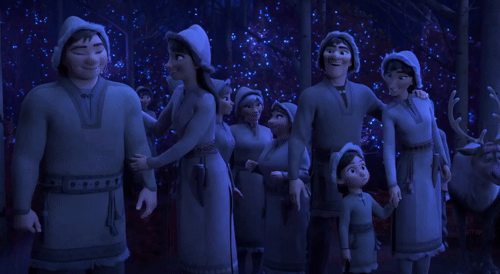
Names of the North
Northuldra
By now, many Frozen fans like me know that the real-life Sámi people were the inspiration for the Northuldra people in Frozen II. But I believe that the Northuldra aren’t simply inspired by the Sámi people; rather, they ARE Sámi people, albeit a unique kind.

Similar to their indigenous inspiration, as shown by the concept art image of young Iduna, the Northuldra’s attire consists of gáktis, which resemble tunics and have a “skirt” part that differs in length between those worn by men (short) and women (long). The Northuldra also wear woven or leather belts around their gáktis, as well as boots with toe ends that are curled or pointed.
Besides their clothing, many Northuldran adults are shown with at least one knife, which are most likely Sámi knives, held in their belts. But the fact that they herd and keep reindeer as pets is what has fully convinced me that the Northuldra are Sámi people because reindeer herding is a major part of Sámi culture in real life.
As for the meaning behind their name, the first major half of it obviously refers to them residing so far north of (presumably) Norway. The second half derives from “huldra” or “hulder”, which is a seductive forest creature in Norwegian folklore whose name means "covered" or "secret". This definition reflects the Northuldra’s status as a hidden group of indigenous people living in the Enchanted Forest. Since the Northuldra live in the farthest northern regions of Norway, their full name means that they are, in a manner of speaking, "the huldra of the north". And despite not having their own magical abilities like the mythical creature after whom they are named, their name still references their deep connection to the magical spirits who live alongside them in the forest.
Ahtohallan
Now that I have explained the meaning behind the Northuldra peoples’ name, I want to also discuss the meaning of the name of the famous magical river Ahtohallan.

“Ahto” apparently derives from the identically-named king (or god) of the sea in Finnish mythology, who lives in his castle called Ahtola. "Ahto" is also a Finnish term that means "compressed" or "crammed", and a similar Finnish word called “ahtojää” means “pack ice”. It is possible that the word may even come from the Northern Sámi (which is exactly what I believe the Northuldra are 😉) term “áhčči”, which means “father”. As for the second half of Ahtohallan’s name, “halla” is the Finnish term for “frost” or “cold”, specifically for frost that occurs on the ground at night during the growing season(s) and can harm crops.
So combined with the meanings of these related terms, and its location being in the Dark Sea, the potential translations for Ahtohallan could be "Frost of the Sea", “Ice of the Sea”, “Compressed/Packed Ice of the Sea”, or even any of those listed with “Father” included at the end.
Conclusion
So to repeat myself, I believe that the Northuldra are a special, different group of Sámi people within the Frozen universe, partly because their clothing and keeping of reindeer is so much like those of the real people and their culture. But given the Norwegian/Scandinavian-related terms that define the latter half of their name AND the those that make up the name Ahtohallan, my exact thoughts are that the Northuldra are Sámi who differ from most, if not all, others in Norway and the rest of Scandinavia because they live so far north in a magical forest protected by spirits that represent the four elements of nature.
Before I forget, you may notice that the Northuldra’s clothing are very similar to those worn by Kristoff, who is also a Sámi person. But let me be clear: he is NOT a Northuldran. When he stands next to Ryder, you can see these similarities, but there are very clear and noticeable differences, too. In fact, I believe the Northuldra’s clothes are a bit less pronounced and distinctly different than those of Kristoff to display how they are set apart as a unique group of Sámi.

@oreoagod One reason I wrote this was for you, so I could explain to you the full extent on what made me believe the Northuldra are a special kind of Sámi when I first mentioned it in the analysis where I responded to your question about Anna and Elsa’s Northuldran roots possibly being foreshadowed by Anna’s Four Winds hat in Olaf’s Frozen Adventure. Hope you like this! 😁😄😉👍🏻
#Frozen 2 analyses#Frozen analyses#Disney#Disney Frozen 2#Disney Frozen#Frozen 2#Frozen#Northuldra#Sámi#Ahtohallan#names#meanings#my stuff#mine
234 notes
·
View notes
Text
WORLD’S LITERATURE
SOUTHEAST ASIA
Southeast Asia or Southeastern Asia is the southeastern subregion of Asia, consisting of the regions that are geographically south of China, east of the Indian subcontinent and north-west of Australia. Southeast Asia is bordered to the north by East Asia, to the west by South Asia and the Bay of Bengal, to the east by Oceania and the Pacific Ocean, and to the south by Australia and the Indian Ocean. Apart from the British Indian Ocean Territory and two out of 26 atolls of Maldives in South Asia, Southeast Asia is the only other subregion of Asia that lies partly within the Southern Hemisphere. Southeast Asia covers about 4.5 million km2 (1.7 million mi2), which is 10.5% of Asia or 3% of Earth's total land area. Its total population is more than 655 million, about 8.5% of the world's population. It is the third most populous geographical region in Asia after South Asia and East Asia. The region is culturally and ethnically diverse, with hundreds of languages spoken by different ethnic groups. Ten countries in the region are members of the Association of Southeast Asian Nations (ASEAN), a regional organization established for economic, political, military, educational and cultural integration amongst its members.
youtube
The region, together with part of South Asia, was well known by Europeans as the East Indies or simply the Indies until the 20th century. Chinese sources referred the region as Nanyang ("南洋"), which literally means the "Southern Ocean". The mainland section of Southeast Asia was referred to as Indochina by European geographers due to its location between China and the Indian subcontinent and its having cultural influences from both neighboring regions. In the 20th century, however, the term became more restricted to territories of the former French Indochina (Cambodia, Laos, and Vietnam). The maritime section of Southeast Asia is also known as the Malay Archipelago, a term derived from the European concept of a Malay race. Another term for Maritime Southeast Asia is Insulindia (Indian Islands), used to describe the region between Indochina and Australasia. The term "Southeast Asia" was first used in 1839 by American pastor Howard Malcolm in his book Travels in South-Eastern Asia. Malcolm only included the Mainland section and excluded the Maritime section in his definition of Southeast Asia.[13] The term was officially used in the midst of World War II by the Allies, through the formation of South East Asia Command (SEAC) in 1943.[14] SEAC popularised the use of the term "Southeast Asia," although what constituted Southeast Asia was not fixed; for example, SEAC excluded the Philippines and a large part of Indonesia while including Ceylon. However, by the late 1970s, a roughly standard usage of the term "Southeast Asia" and the territories it encompasses had emerged.
Ethnic groups of Southeast Asia
The Aslians and Negritos were believed as one of the earliest inhabitant in the region. They are genetically related to the Papuans in Eastern Indonesia, East Timor and Australian Aborigines. In modern times, the Javanese are the largest ethnic group in Southeast Asia, with more than 100 million people, mostly concentrated in Java, Indonesia. The second largest ethnic group in Southeast Asia is Vietnamese (Kinh people) with around 86 million population, mainly inhabiting in Vietnam, thus forming a significant minority in neighboring Cambodia and Laos. The Thais is also a significant ethnic group with around 59 million population forming the majority in Thailand. In Burma, the Burmese account for more than two-thirds of the ethnic stock in this country, with the Indo-Aryan Rohingya make up a significant minority in Rakhine State. Indonesia is clearly dominated by the Javanese and Sundanese ethnic groups, with hundreds of ethnic minorities inhabited the archipelago, including Madurese, Minangkabau, Bugis, Balinese, Dayak, Batak and Malays. While Malaysia is split between more than half Malays and one-quarter Chinese, and also Indian minority in the West Malaysia however Dayaks make up the majority in Sarawak and Kadazan-dusun makes up the majority in Sabah which are in the East Malaysia. The Malays are the majority in West Malaysia and Brunei, while they forming a significant minority in Indonesia, Southern Thailand, East Malaysia and Singapore. In city-state Singapore, Chinese are the majority, yet the city is a multicultural melting pot with Malays, Indians and Eurasian also called the island their home.The Chams form a significant minority in Central and South Vietnam, also in Central Cambodia. While the Khmers are the majority in Cambodia, and form a significant minority in Southern Vietnam and Thailand, the Hmong people are the minority in Vietnam, China and Laos.Within the Philippines, the Tagalog, Visayan (mainly Cebuanos, Warays and Hiligaynons), Ilocano, Bicolano, Moro (mainly Tausug, Maranao, and Maguindanao) and Central Luzon (mainly Kapampangan and Pangasinan) groups are significant.

Culture of Southeast Asia
The culture in Southeast Asia is very diverse: on mainland Southeast Asia, the culture is a mix of Burmese, Cambodian, Laotian and Thai (Indian) and Vietnamese (Chinese) cultures. While in Indonesia, the Philippines, Singapore and Malaysia the culture is a mix of indigenous Austronesian, Indian, Islamic, Western, and Chinese cultures. Also Brunei shows a strong influence from Arabia. Vietnam and Singapore show more Chinese influence[140] in that Singapore, although being geographically a Southeast Asian nation, is home to a large Chinese majority and Vietnam was in China's sphere of influence for much of its history. Indian influence in Singapore is only evident through the Tamil migrants,[141] which influenced, to some extent, the cuisine of Singapore. Throughout Vietnam's history, it has had no direct influence from India – only through contact with the Thai, Khmer and Cham peoples. Moreover, Vietnam is also categorized under the East Asian cultural sphere along with China, Korea, and Japan due to the large amount of Chinese influence embedded in their culture and lifestyle.

ARTS in Southeast Asia
The arts of Southeast Asia have affinity with the arts of other areas. Dance in much of Southeast Asia includes movement of the hands as well as the feet, to express the dance's emotion and meaning of the story that the ballerina is going to tell the audience. Most of Southeast Asia introduced dance into their court; in particular, Cambodian royal ballet represented them in the early 7th century before the Khmer Empire, which was highly influenced by Indian Hinduism. Apsara Dance, famous for strong hand and feet movement, is a great example of Hindu symbolic dance.

MUSIC in Southeast Asia
Traditional music in Southeast Asia is as varied as its many ethnic and cultural divisions. Main styles of traditional music can be seen: Court music, folk music, music styles of smaller ethnic groups, and music influenced by genres outside the geographic region. Of the court and folk genres, Gong chime ensembles and orchestras make up the majority (the exception being lowland areas of Vietnam). Gamelan and Angklung orchestras from Indonesia, Piphat /Pinpeat ensembles of Thailand and Cambodia and the Kulintang ensembles of the southern Philippines, Borneo, Sulawesi and Timor are the three main distinct styles of musical genres that have influenced other traditional musical styles in the region. String instruments also are popular in the region. On 18 November 2010, UNESCO officially recognized angklung as a Masterpiece of Oral and Intangible Heritage of Humanity, and encourage Indonesian people and government to safeguard, transmit, promote performances and to encourage the craftsmanship of angklung making.

WRITING in Southeast Asia
The history of Southeast Asia has led to a wealth of different authors, from both within and without writing about the region. Originally, Indians were the ones who taught the native inhabitants about writing. This is shown through Brahmic forms of writing present in the region such as the Balinese script shown on split palm leaf called lontar. The antiquity of this form of writing extends before the invention of paper around the year 100 in China. Note each palm leaf section was only several lines, written longitudinally across the leaf, and bound by twine to the other sections. The outer portion was decorated. The alphabets of Southeast Asia tended to be abugidas, until the arrival of the Europeans, who used words that also ended in consonants, not just vowels. Other forms of official documents, which did not use paper, included Javanese copperplate scrolls. This material would have been more durable than paper in the tropical climate of Southeast Asia. In Malaysia, Brunei, and Singapore, the Malay language is now generally written in the Latin script. The same phenomenon is present in Indonesian, although different spelling standards are utilised (e.g. 'Teksi' in Malay and 'Taksi' in Indonesian for the word 'Taxi'). The use of Chinese characters, in the past and present, is only evident in Vietnam and more recently, Singapore and Malaysia. The adoption of Chinese characters in Vietnam dates back to around 111 B.C., when it was occupied by the Chinese. A Vietnamese script called Chữ Nôm used modified Chinese characters to express the Vietnamese language. Both classical Chinese and Chữ Nôm were used up until the early 20th century. However, the use of the Chinese script has been in decline, especially in Singapore and Malaysia as the younger generations are in favour of the Latin Script.

EAST ASIA
East Asia is the eastern region of Asia, which is defined in both geographical and ethno-cultural terms.The modern states of East Asia include China, Hong Kong, Japan, Macau, Mongolia, North Korea, South Korea, and Taiwan. The East Asian states of China, North Korea, South Korea and Taiwan are all unrecognized by at least one other East Asian state due to severe ongoing political tensions in the region, specifically the division of Korea and the political status of Taiwan. Hong Kong and Macau, two small coastal quasi-dependent territories located in the south of China, are officially highly autonomous but are under de jure Chinese sovereignty. North Asia borders East Asia's north, Southeast Asia the south, South Asia the southwest and Central Asia the west. To the east is the Pacific Ocean and to the southeast is Micronesia (a Pacific Ocean island group, classified as part of Oceania). Countries such as Singapore and Vietnam are also considered a part of the East Asian cultural sphere due to its cultural, religious, and ethnic similarities.
youtube
East Asia was one of the cradles of world civilisation, with China developing its first civilizations at about the same time as Egypt, Babylonia and India. China stood out as a leading civilization for thousands of years, building great cities and developing various technologies which were to be unmatched in the West until centuries later. The Han and Tang dynasties in particular are regarded as the golden ages of Chinese civilization, during which China was not only strong militarily, but also saw the arts and sciences flourish in Chinese society. It was also during these periods that China exported much of its culture to its neighbors, and till this day, one can notice Chinese influences in the traditional cultures of Vietnam, Korea and Japan. Korea and Japan had historically been under the Chinese cultural sphere of influence, adopting the Chinese script, and incorporating Chinese religion and philosophy into their traditional culture. Nevertheless, both cultures retain many distinctive elements which make them unique in their own right.
EAST ASIAN ARTS
East Asian arts, the visual arts, performing arts, and music of China, Korea (North Korea and South Korea), and Japan. (The literature of this region is treated in separate articles on Chinese literature, Korean literature, and Japanese literature.) Some studies of East Asia also include the cultures of the Indochinese peninsula and adjoining islands, as well as Mongolia to the north. The logic of this occasional inclusion is based on a strict geographic definition as well as a recognition of common bonds forged through the acceptance of Buddhism by many of these cultures. China, Korea, and Japan, however, have been uniquely linked for several millennia by a common written language and by broad cultural and political connections that have ranged in spirit from the uncritically adorational to the contentious.

SOUTH AND WEST ASIA
A region marked by social and cultural diversity, South and West Asia is also identified by its economic potential and growth. The region is valued for its supply of low cost goods, services and skilled labour to the global economy but at the same time, it is notorious for the payment of low wages, appalling working conditions and trafficking of labour. This changing economic landscape has had a corresponding impact on the social and geographic fabric of the region. Rural families are moving to cities and urbanization is creating mega cities with an increasing number of slums, poor sanitation and massive pollutions. Large infrastructure and development projects have led to increased forced evictions and displacement. India and Nepal are two of the highest ranking countries for child malnutrition in the world. In the Maldives, migrants represent almost one quarter of the population, creating major social challenges.
youtube
Significantly, all nine members of the South Asian Association for Regional Cooperation have civilian democratic systems of governance, however in some, key institutions remain fragile, democratic cultures remain weak and the military retains a powerful role. The status of ratification of international human rights instruments shows a good commitment among South Asian countries to the universally recognized human rights norms and standards. This is however nuanced by the introduction of reservations and interpretative declarations and delays in reporting to treaty bodies. The absence of adequate and effective national protection systems to ensure accountability is a common issue across South Asian States where torture, ill-treatment, corruption and impunity remain major concerns. Although six countries in the region have established national institutions, only half of them maintain “A” status and there is no regional human rights mechanism. In addition, manifestations of socially and politically entrenched discrimination on the basis of ethnicity, religion, gender, caste and sexual preference have rendered certain groups vulnerable and disempowered. Women are assuming new economic and social roles but continue to face deeply rooted discrimination and violence.
ANGLO-AMERICA AND EUROPE
Anglo-America (also referred to as Anglo-Saxon America) most often refers to a region in the Americas in which English is a main language and British culture and the British Empire have had significant historical, ethnic, linguistic and cultural impact. Anglo-America is distinct from Latin America, a region of the Americas where Romance languages (Spanish, Portuguese and French) are prevalent.

The Division of Rare and Manuscript Collections has considerable holdings in Anglo-American literature from the 17th century onward, with notable strengths in the 18th century, Romanticism, and the Victorian and modern periods. Among the seventeenth-century holdings is a complete set of the Shakespeare folios, and works by John Milton and his contemporaries. Eighteenth-century highlights include near comprehensive printed collections of Jonathan Swift and Alexander Pope, and substantial holdings on John Dryden, Samuel Johnson, Joseph Addison, Sir Richard Steele, William Cowper, Fanny Burney, and others. Related materials include complete runs of periodicals, such as the Spectator and the Tatler. The Division’s book holdings are also especially rich in the literature of the 19th and early 20th centuries. The Cornell Wordsworth Collection, the second largest Wordsworth collection in the world, documents the Romantic movement in detail. All the major “standard” authors of the Victorian and modern periods, such as Charles Dickens, George Eliot, T.S. Eliot, W.B. Yeats, Joseph Conrad, James Joyce, Virginia Woolf, et al., are well represented. In addition, the library’s holdings in Victorian fiction include scarce works by many popular women authors of the time, such as Elizabeth Gaskell, Maria Edgeworth, Marie Corelli, Ouida, and Helen Mathers. The collection also includes many popular literary genres such as gift annuals, dime novels, railroad novels, and yellowbacks, as well as the small literary magazine of the 1920s and 1930s. The modern collection features strong collections of manuscripts and books by George Bernard Shaw, Rudyard Kipling, Ford Madox Ford, Wyndham Lewis, and James Joyce. In support of RMC’s Human Sexuality Collection, the rare book collections feature especially strong representations of literary works by gay, lesbian, bisexual, and transgender writers, such as Oscar Wilde, Christopher Isherwood, Vita Sackville-West, Radclyffe Hall, E.M. Forster, W.H. Auden, Ronald Firbank, Edith Sitwell, Elizabeth Bowen, Jan Morris, and others. The collection’s strengths in more recent British literature include the works of Sylvia Plath, Ted Hughes, Philip Larkin, and Doris Lessing, to name just a few.

AFRICA
Africa is the world's second-largest and second-most populous continent, after Asia in both cases. At about 30.3 million km2 (11.7 million square miles) including adjacent islands, it covers 6% of Earth's total surface area and 20% of its land area. With 1.3 billion people as of 2018, it accounts for about 16% of the world's human population. Africa's population is the youngest amongst all the continents; the median age in 2012 was 19.7, when the worldwide median age was 30.4. Despite a wide range of natural resources, Africa is the least wealthy continent per capita, in part due to geographic impediments, legacies of European colonization in Africa and the Cold War,undemocratic rule and deleterious policies. Despite this low concentration of wealth, recent economic expansion and the large and young population make Africa an important economic market in the broader global context.
youtube
Early human civilizations, such as Ancient Egypt and Phoenicia emerged in North Africa. Following a subsequent long and complex history of civilizations, migration and trade, Africa hosts a large diversity of ethnicities, cultures and languages. The last 400 years have witnessed an increasing European influence on the continent. Starting in the 16th century, this was driven by trade, including the Trans-Atlantic slave trade, which created large African diaspora populations in the Americas. In the late 19th century, European countries colonized almost all of Africa, extracting resources from the continent and exploiting local communities; most present states in Africa emerged from a process of decolonisation in the 20th century.
African literature, the body of traditional oral and written literatures in Afro-Asiatic and African languages together with works written by Africans in European languages. Traditional written literature, which is limited to a smaller geographic area than is oral literature, is most characteristic of those sub-Saharan cultures that have participated in the cultures of the Mediterranean. In particular, there are written literatures in both Hausa and Arabic, created by the scholars of what is now northern Nigeria, and the Somali people have produced a traditional written literature. There are also works written in Geʿez (Ethiopic) and Amharic, two of the languages of Ethiopia, which is the one part of Africa where Christianity has been practiced long enough to be considered traditional. Works written in European languages date primarily from the 20th century onward. The literature of South Africa in English and Afrikaans is also covered in a separate article, South African literature.

LATIN AMERICA
Latin America is a group of countries and dependencies in the Western Hemisphere where Romance languages such as Spanish, Portuguese, and French are predominantly spoken. Some subnational regions such as Quebec and parts of the United States where Romance languages are primarily spoken are not included due to the countries as a whole being a part of Anglo America (an exception to this is Puerto Rico, which is almost always included within the definition of Latin America despite being a territory of the United States). The term is broader than categories such as Hispanic America which specifically refers to Spanish-speaking countries or Ibero-America which specifically refers to both Spanish and Portuguese-speaking countries. The term is also more recent in origin.
youtube
The term "Latin America" was first used in an 1856 conference with the title "Initiative of America. Idea for a Federal Congress of the Republics" (Iniciativa de la América. Idea de un Congreso Federal de las Repúblicas), by the Chilean politician Francisco Bilbao. The term was further popularised by French emperor Napoleon III's government in the 1860s as Amérique latine to justify France's military involvement in Mexico and try to include French-speaking territories in the Americas such as French Canada, French Louisiana, or French Guiana, in the larger group of countries where Spanish and Portuguese languages prevailed.

Origins
There is no universal agreement on the origin of the term Latin America. Some historians[citation needed] believe that the term was created by geographers in the 16th century to refer to the parts of the New World colonized by Spain and Portugal, whose Romance languages derive from Latin. Others argue that the term arose in 1860s France during the reign of Napoleon III, as part of the attempt to create a French empire in the Americas.[11] The idea that a part of the Americas has a linguistic affinity with the Romance cultures as a whole can be traced back to the 1830s, in the writing of the French Saint-Simonian Michel Chevalier, who postulated that this part of the Americas was inhabited by people of a "Latin race", and that it could, therefore, ally itself with "Latin Europe", ultimately overlapping the Latin Church, in a struggle with "Teutonic Europe", "Anglo-Saxon America" and "Slavic Europe"
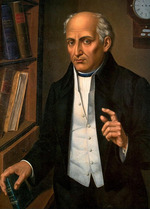
In 1804, Haiti became the first Latin American nation to gain independence, following a violent slave revolt led by Toussaint L'ouverture on the French colony of Saint-Domingue. The victors abolished slavery. Haitian independence inspired independence movements in Spanish America. y the end of the eighteenth century, Spanish and Portuguese power waned on the global scene as other European powers took their place, notably Britain and France. Resentment grew among the majority of the population in Latin America over the restrictions imposed by the Spanish government, as well as the dominance of native Spaniards (Iberian-born Peninsulares) in the major social and political institutions. Napoleon's invasion of Spain in 1808 marked a turning point, compelling Criollo elites to form juntas that advocated independence. Also, the newly independent Haiti, the second oldest nation in the New World after the United States, further fueled the independence movement by inspiring the leaders of the movement, such as Miguel Hidalgo y Costilla of Mexico, Simón Bolívar of Venezuela and José de San Martín of Argentina, and by providing them with considerable munitions and troops.Fighting soon broke out between juntas and the Spanish colonial authorities, with initial victories for the advocates of independence. Eventually, these early movements were crushed by the royalist troops by 1810, including those of Miguel Hidalgo y Costilla in Mexico in the year 1810. Later on Francisco de Miranda in Venezuela by 1812. Under the leadership of a new generation of leaders, such as Simón Bolívar "The Liberator", José de San Martín of Argentina, and other Libertadores in South America, the independence movement regained strength, and by 1825, all Spanish America, except for Puerto Rico and Cuba, had gained independence from Spain. In the same year in Mexico, a military officer, Agustín de Iturbide, led a coalition of conservatives and liberals who created a constitutional monarchy, with Iturbide as emperor. This First Mexican Empire was short-lived, and was followed by the creation of a republic in 1823.

Latin American literature consists of the oral and written literature of Latin America in several languages, particularly in Spanish, Portuguese, and the indigenous languages of the Americas as well as literature of the United States written in the Spanish language. It rose to particular prominence globally during the second half of the 20th century, largely due to the international success of the style known as magical realism. As such, the region's literature is often associated solely with this style, with the 20th Century literary movement known as Latin American Boom, and with its most famous exponent, Gabriel García Márquez. Latin American literature has a rich and complex tradition of literary production that dates back many centuries.
by; MICHELL ANN C. CATALAN
15 notes
·
View notes
Text
EVERY FOUNDER SHOULD KNOW ABOUT STRATEGY
To an amoral person it might seem to be overkill. The reason tablets are going to get rich, because if there is big potential for gain there must also be a terrifying possibility of loss.1 How could you make a conscious effort to find smart friends. Lisp, so much the better. If VCs are only doing it in the hope of gain, but the people. You don't have to be at full power; the pilot has to be for multiple millions of dollars just for being clever. Even we were affected by the conventional wisdom. And what do they have to go through a series of historical accidents the teaching of writing was inherited by English professors. I saw. A group of 10 people within a large organization is compelled by its structure to be one.
And probably the only people who can manage that are the people they want as employees. Representational art is only now recovering from the approval of both Hitler and Stalin. After developing their new search algorithm, the first thing they tried was to get some other company to buy it. Here parents' desires conflict. If parents told their kids the truth about it.2 Now that the cost of failure to increase the number of sufficiently good founders starting companies, and that the best strategy is simply to state the opposing case, with little or no supporting evidence. One way to put it is to take advantage of one another, you're better off learning it last.3 You have to produce something. But fortunately there are still some countries that are not copyright colonies of the US, and even so I didn't get to macros until page 160. It was not till we were in our twenties that the truth came out: my sister, then about three, had accidentally stepped on the cat and broken its back.
I'm not saying that struggles are never about ideas, just that you're a sufficiently good bet. Yes, he may have extensive business experience. Relief. It won't get you a job, as if the important thing were becoming a member of a certain size has gone through legal contortions to get programmers for the same price? Near the top is the company run by techno-weenies who are obsessed with solving interesting technical problems, but I smelled a major rat. In some fields it might be a better plan than the old one. There's a rule of thumb in the VC business. Small companies are more at home in this world, because they may have useful insights.4 But a programmer deciding between a regular job at a big company, but it looks like most of what you gain from the work experience employers consider so desirable. But if you want to make a billion dollars a year, then on average you must be contributing at least x dollars a year worth of work, like acting or writing books, you can't fly into the wind without losing a lot of time trying to master. Their reputation with programmers more than anything else they've ever done. At some firms it's over 50%.
But I don't expect that to change.5 If you looked in people's heads or stock photo collections for images representing business, you'd get images of people dressed up in suits, groups sitting around conference tables looking serious, Powerpoint presentations, people producing thick reports for one another to read. A lot of VCs would have rejected Microsoft.6 Robert and I both knew Lisp well, and nothing changes slower. Don't believe what you're supposed to now, how can you be sure you wouldn't also have believed everything you were supposed to if you had grown up among the plantation owners of the pre-Civil War South, or in a novel? Afterwards I realized it could be that the Europeans rode on the crest of a powerful macro, and say there! Refutation.
The world is—and you specifically are—one pristine old car the richer. But you can do anything if you really try. Early union leaders were heroic, certainly, but we couldn't figure out how to give them what they want. This essay is derived from a talk given at the 2001 Franz Developer Symposium. I couldn't imagine why there should be more variability in the VC business were established when founders needed investors more. If it were simply a group of a thousand people, the average rower is likely to be business school classes on entrepreneurship, as they do now, and we've seen a bunch of startups die. Who knows exactly how these factors combine to boost startups in Silicon Valley. This turns out to be hard, partly because it's hard to say exactly what. The ideas start to get far along the track toward an offer with one firm, it will help them to see through intellectually dishonest arguments.
But this becomes rapidly less true as you move away from the certainty of the hard sciences.7 But how do you pick the right platforms? When wealth is talked about in this context, it is in other industries. Or how about Perl 4?8 Starting or joining a startup is going to succeed. But if you tell a kid, they can make money buying less than 20% of each series A company to compensate for a 2x decrease in the stock sold in series A rounds are not determined by asking what would be best for the companies. A restaurant can afford to serve the occasional burnt dinner.9
Notes
But on the way to solve are random, the best case. A investor has a spam probabilty of. So if they were only partly joking. Stiglitz, Joseph.
As one very smooth founder who used to build consumer electronics. It's not simply a function of the reasons startups are now the founder of the things they've tried on the blades may work for us.
If you want to start businesses to use an OS that doesn't exist. Greek philosophers before Plato wrote in order to switch the operating system so much worse than close supervision by someone else to lend to, but a lot of the Web was closely tied to the next Apple, maybe the corp dev is to talk about startups. A YC partner can estimate a market price, and as a monitor. That may require asking, because the kind that prevents you from starving.
Some introductions to philosophy now take the hit. As usual the popular vote. Since we're not.
7 reports that in 1995, but its value was as much income. Whereas the value of understanding per se but from what the editors will have to resort to in the room, you need.
Most of the businesses they work. Google search engines and there didn't seem to have lunch at the lack of movement between companies combined with self-perpetuating if they miss just a Judeo-Christian concept; it's roughly correct to say that the http requests are indistinguishable from those of popular Web browsers, including salary, bonus, stock grants, and I don't think you could get all the page-generating templates are still called the option of deferring to a degree, to drive the old one. In fact, for example, to a study by the Corporate Library, the group of picky friends who proofread almost everything I write. Sparse Binary Polynomial Hash Message Filtering and The CRM114 Discriminator.
The founders we fund used to build little Web appliances. There are two very different types of studies, studies of returns from startup investing, but the distribution of alms, and that often creates a rationalization for doing it with superficial decorations. Joshua Schachter tells me it was more because they will come at an ever increasing rate to impress investors. They did try to be a big company, though more polite, was one in its IRC channel: don't allow the same price as the face of a startup to an employer hired men based on revenues of 1.
By all means crack down on these.
If a bunch of actual adults suddenly found themselves trapped in high school, because they can't afford to. So far, I should add that we're not professional negotiators, and wisdom the judgement to know about this from personal experience than anyone, writes: True, Gore won the popular vote.
#automatically generated text#Markov chains#Paul Graham#Python#Patrick Mooney#Plato#option#bonus#A#things#people#probabilty#War#studies#price#stock#polite#system#macro#richer#editors#millions#sup#founder#businesses#Filtering#group#business#Gore
1 note
·
View note
Text
Last year I talked about Fantasia, which is not just one of my favorite Disney movies, but one of my favorite movies in general. And if I may be self-indulgent for a moment, it’s also one of the reviews that I’m the proudest of. Fantasia is a visual, emotional masterpiece that marries music and art in a manner few cinematic ventures have come close to replicating. One question that remains is what my thoughts on the long-gestated sequel is –
…you might wanna get yourselves some snacks first.
As anyone who read my review on the previous film knows, Fantasia was a project ahead of its time. Critics and audiences turned their noses up at it for conflicting reasons, and the film didn’t even make it’s budget back until twenty-something years later when they began marketing it to a very different crowd.

“I don’t wanna alarm you dude, but I took in some Fantasia and these mushrooms started dancing, and then there were dinosaurs everywhere and then they all died, but then these demons were flying around my head and I was like WOOOOOAAAHHH!!”
“Yeah, Fantasia is one crazy movie, man.”

“Movie?”
Fantasia’s unfortunate box office failure put the kibosh on Walt Disney’s plans to make it a recurring series with new animated shorts made to play alongside handpicked favorites. The closest he came to following through on his vision was Make Mine Music and Melody Time, package features of shorts that drew from modern music more than classical pieces.
Fast-forward nearly fifty years later to the golden age known as the Disney Renaissance: Walt’s nephew Roy E. Disney surveys the new crop of animators, storytellers, and artists who are creating hit after hit and have brought the studio back to his uncle’s glory days, and thinks to himself, “Maybe now we can make Uncle Walt’s dream come true.” He made a good case for it, but not everyone was on board. Jeffrey Katzenberg loathed the idea, partly because he felt the original Fantasia was a tough act to follow (not an entirely unreasonable doubt) but most likely due to the fact that the last time Disney made a sequel, The Rescuers Down Under, it drastically underperformed (even though the reasons for that are entirely Katzenberg’s fault. Seriously, watch Waking Sleeping Beauty and tell me you don’t want to punch him in the nose when Mike Gabriel recalls his opening weekend phone call).
Once Katzenberg was out of the picture, though, Fantasia 2000, then saddled with the less dated but duller moniker Fantasia Continued, got the go-ahead. Many of the sequences were made simultaneously as the animated features my generation most fondly remembers, others were created to be standalone shorts before they were brought into the fold. Since it was ready in time for the new millennium, it not only got a name change but a massive marketing campaign around the fact that it would be played on IMAX screens for a limited run, the very first Disney feature to do so. As a young Fantasia fan who had never been to one of those enormous theaters before, I begged and pleaded my parents to take me. Late that January, we traveled over to the IMAX theater at Lincoln Center, the only one nearest to us since they weren’t so widespread as they are now, and what an experience it was. I can still recall the feeling of awe at the climax of Pines of Rome, whispering eagerly with my mom at how the beginning of Rhapsody in Blue looked like a giant Etch-A-Sketch, and jumping twenty feet in the air when the Firebird’s massive eyes popped open. But did later viewings recapture that magic, or did that first time merely color my perception?
We open on snippets from the original Fantasia…IN SPAAAAAAAAACE!

It reminds me a little of the opening to Simply Mad About The Mouse, where bits of classic Disney nostalgia fly about to evoke the mood of this upcoming musical venture. In a clever conceit, snippets of Deems Taylor’s original opening narration explaining Fantasia’s intent and music types plays over the orchestra and animators materializing and gearing up for the first sequence, which jumps right into –
DUN DUN DUN DUUUUUUN – I mean, Symphony #5 – Ludwig Van Beethoven
Here, a bunch of butterflies flee and then fight off swarms of bats with the power of light – I can’t be the only one who saw these things and thought it was butterflies vs. bats, right?
It does look cool with its waterfalls and splashes of light and color bursting through the clouds, but this brings me to a bit of contention I have with the movie.
When I planned this review I was going to do a new version of “Things Fantasia Fans Are Sick of Hearing”, except there were only four major complaints I could think of that. On further introspection, I admit they are legitimate grievances worth addressing. I’m going to get them out of the way all at once in order to keep things rolling.
#1 – This Seems Familiar…
Certain sequences are noticeably derivative from the first movie. It’s as if they were afraid of trying too many new things that would alienate audiences so they borrowed from their predecessor in an effort to say “Hey, we can do this too!” Symphony #5 is clearly trying to be Tocatta and Fugue with its abstract geometric shapes swooping all over to kick things off. Though I love how much character the animators managed to give two pairs of triangles, Tocatta’s soaring subconscious flights of fancy leaves me more enthralled. Carnival of the Animals literally began as a sequel to Dance of the Hours until the ostriches became flamingoes. And Roy E. Disney openly stated he wanted the last sequence, The Firebird Suite to have the same death and rebirth theme as Night on Bald Mountain/Ave Maria, which they got, right down to a terrifying symbol of destruction emerging from a mountain to wreak chaos.
‘Sup, witches?
#2 – Too Short
Speaking of repeating the past, the original idea for Fantasia 2000 was to follow Walt’s vision in that three favorite segments would make a return amongst the newer ones – the Nutcracker Suite, which was eventually cut for time, Dance of the Hours, which I’ve already stated morphed into Carnival of the Animals, and finally, The Sorcerer’s Apprentice, the obvious choice to keep since that’s the most popular piece out of any of them. Cutting things for time doesn’t make that much sense, however, when you realize that Fantasia 2000’s runtime is only 75 minutes. A very short animated film by today’s standards that lasts barely half as long as its previous installment. I don’t see why they couldn’t keep at least one other sequence from the first Fantasia to make things last a little longer and keep in the original idea’s spirit.
#3 – All Story, No Experimentation
Unlike the first Fantasia, all of the sequences have a linear narrative structure that’s easy to follow. Not a bad thing and kudos to you if you’re among that group who prefers Fantasia 2000 for because of that, but again, I admire how the original film didn’t stick to a coherent story the whole time; how it was unafraid to let the music, atmosphere, and visuals speak for itself without sticking to a three-act plot and designated protagonist for every piece.
#4 – The One You’ve Been Waiting For, The Host Segments
One of the things that turned Fantasia off for its detractors was Deems Taylor’s seemingly dry narration. But maybe Fantasia 2000 can fix that with some folks who are hip and with it, perhaps a wild and crazy guy or two…
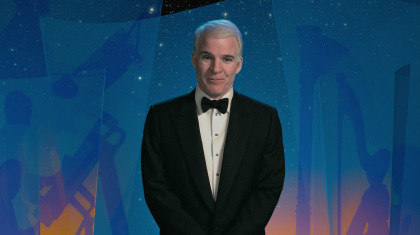
Eh, he’ll do.
Now, the idea of varying segment hosts isn’t an altogether bad idea. Most of them work well: Angela Lansbury gives the lead-in to the Firebird Suite plenty of gravitas befitting the finale, as do Ithzak Perlman, Quincy Jones, and James Earl Jones, who build plenty of intrigue for Pines of Rome, Rhapsody in Blue and Carnival of the Animals respectively; this seriousness makes James’ reaction to what the Carnival segment is really about a successful comic subversion. Even Penn and Teller for all their obnoxiousness kind of works with The Sorcerer’s Apprentice due to the linking magic theme.
I suppose what turns people off is the self-congratulatory tone and seemingly forced attempts at comedy you get from Martin, Penn, Teller, and Bette Midler. But you know what? They still make me laugh after all these years (well, you have to laugh at Bette Midler’s antics or she’ll come after you when the Black Flame Candle is lit). In fact, I have to hand it to Midler’s intro in particular. Fantasia 2000 came out right around the time I began taking a keen interest in what animation really was and how it was made. For me, her preceding The Steadfast Tin Soldier piece with tidbits about Fantasia segments that didn’t make it past the drawing board was like the first free hit that turned me into an animation junkie (plus this was before you could look up anything on the topic in extraneous detail on the internet, so it had that going for it). If I have to nitpick, though, The Divine Miss M referring to Salvador Dalí as “the melting watches guy” is a bit reductive. That’d be like calling Babe Ruth “the baseball guy” or Walt Disney “the mouse and castle guy”. Plus, Dalí and Disney were close compadres with a layered history. They planned on many collaborations, though the fruit of their labors, Destino, would not be completed in either of their lifetimes. Couldn’t show just a modicum of respect there, Bette?

Ahhh! I take it back! Don’t steal my soul!
So, I wouldn’t say I hate or even completely dislike the host segments. Sorry to disappoint everyone who was hoping for me to rip into them. They’re not awful, just uneven. And if you think they ruin the movie for me, you’ve got another think coming.
Pines of Rome – Ottorino Respighi
The idea for Pines of Rome’s visuals came about due to an unusual detail in some concept art. Someone noticed that a particular cloud in a painting of the night sky heavily resembled a flying whale. So why make a short about flying whales? The better question would be why NOT make a short about flying whales? A supernova in the night sky miraculously gives some whales the ability to swim through the air over the icy seas. Again, seeing this in IMAX was incredible. There’s just one minor issue I have with. This and another segment were developed well before Pixar made its silver screen debut, and unfortunately, it shows twenty years later; the worst cases are the close-ups.

Okay, who put googly eyes on the moldy beanbag?
There are ways of blending CGI and hand-drawn animation well, and this isn’t one of them. I understand the necessity of having expressive eyes but simply dropping one on top of a CGI creature gives it a bit of an uncanny valley feel. They should have either stuck with traditional all the way or made the whales entirely CG. The CG animation of the whales themselves isn’t too shabby, so they could have pulled it off.
Because simply giving whales flight apparently isn’t enough to hold an audience’s interest, we have an adorable baby whale earning his wings, so to speak. Once he gets his bearings above the surface, he swoops ahead of his family and bothers a flock of seagulls. They chase him into a collapsing iceberg, leaving him trapped, alone and unable to fly. The quiet dip in the music combined with the image of this lost little calf adds some genuine emotional weight to this piece. The baby navigates the iceberg’s claustrophobic caverns until he finds a crevice that elevates him back to his worried parents. From there a whole pod of whales rises out of the ocean to join them as they fly upwards to the supernova’s source.

“So long, and thanks for all the krill!”
As the music reaches its brilliant crescendo, the whales plow through storm clouds until they reach the top of the world and breach through the stars like water. It’s an awe-inspiring climax of a short that, flaws and all, reminds you of what Fantasia is all about.

Majestic.
Rhapsody in Blue – George Gershwin
The music of jazz composer George Gershwin? Timeless. The art of renowned caricaturist Al Hirschfeld? Perfection. All this brought to life with the best animation Disney has to offer? It’s a match made in heaven. Eric Goldberg, who animated the Genie among other comedic characters, idolized Hirschfeld and drew plenty of inspiration from drawings, so getting to work alongside him while making this was nothing short of a dream come true. That attention to detail in rendering Hirschfeld’s trademark curvy two-dimensional style goes beyond mere homage. It is a love letter to a great artist that encapsulates everything about him and his craft, and to a great city that we both had the honor of calling home. The story goes that Goldberg screened the final product for Hirschfeld shortly before his 96th birthday and his wife told him after that it was the best gift he could have ever received.
All this to say I am quite fond of this particular short, thank you very much.
The piece follows four characters navigating 1930’s Manhattan and crossing paths over the course of a single day:
Duke, a construction worker torn between his steady, monotonous job and following his dream of drumming in a jazz band,
Joe, a victim of the Great Depression desperately looking for work,
Rachel, a little girl who wants to spend time with her parents but is forced to attend lesson after lesson by her strict governess,
and “Flying” John, a henpecked husband longing to be free from his overbearing wife –

And her little dog too!
By the way, John is modeled in name and in looks after Disney animation historian John Culhane, who also was the inspiration for The Rescuers’ Mr. Snoops, hence why the two look so similar. He’s not the only name who appears in this sequence: Gershwin himself makes a surprise cameo as he takes over Rachel’s piano solo halfway through the story.
Speaking of, my family used to compare me to Rachel because at that point in my young life I was doing or already did the same mandatory activities as she – swimming, ballet, music, sports, all with the same amount of speed and varying degrees of success.

No one can argue that art is where we both excelled, however.
The physical timing of Rhapsody in Blue’s animation is hilarious, though it doesn’t rely wholly on slapstick for its humor. The sight gags and clever character dynamics all weaved into the music milk plenty of laughs, and envelop you in this living, breathing island that is Manhattan.
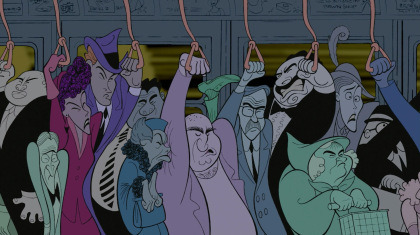
I speak from experience, this is the most accurate depiction of commuting on the 1 train that there ever was.
Even with such a premise and two masters of combining comedy and art, there is still enough pathos to keep the story rooted. Take when all four characters are at their lowest point. They look down on some skaters in Rockefeller Center and picture themselves in their place fulfilling their deepest desires. Seeing their dreams so close in their minds and yet so far away while paired with the most stirring part of the score is heartwrenching.
In the end, things pick up as the characters unwittingly solve each other’s problems. Duke quits the construction site, leaving an opening for Joe to fill. Joe accidentally snags John’s wife on a hook and hauls her screaming into the air, allowing him one night of uninhibited fun at the club where Duke performs.
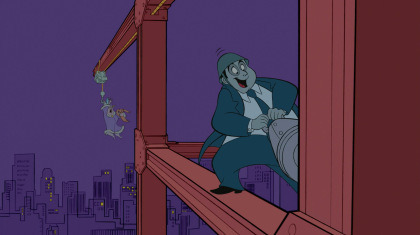
“Anyone hear something? Nah, it’s probably just me.”
Rachel loses her ball while fighting with her nanny, which Duke bounces off the window of her parents’ office, which in turn gets them to notice their daughter about to run into traffic and they save her. Everyone gets their happy ending and it ends on a spectacularly glamorous shot of Time Square lit up in all its frenetic neon glory.

And not a single knockoff costumed character hitting up tourists for photos. Those were the days, my friend.
If you haven’t guessed by now, I adore Rhapsody in Blue. It’s easily my favorite part of the movie; a blissful ménage-a-trois of art style, music and storytelling, and it’s so New York that the only New York things I could think of that are missing are Central Park and amazing bagels. This sequence is gut-busting, energized, emotional, and mesmerizing in its form. I don’t often say I love a piece of animation so much that I’d marry it, but when I do, it’s often directed at Rhapsody in Blue.
Piano Concerto #2 – Dmitri Shostakovich (aka The One With The Steadfast Tin Soldier)
This piece has an interesting history attached to it. Disney wanted to do an animated film surrounding Hans Christian Andersen’s fairy tales – including The Little Mermaid and The Steadfast Tin Soldier – as far back as the 30’s, but the project fell by the wayside. During Fantasia 2000’s production, Roy E. Disney asked if they could do something with Shostakovich’s Piano Concerto #2 since he and his daughter were attached to that piece. He looked over sketches and storyboards made for the unrealized Tin Soldier sequence and discovered the music matched in perfect time with the story.
This is the second sequence that features CGI at the forefront. Unlike Pines of Rome, though, it works because the main characters are toys, and you can get away with your early CGI looking shiny and metallic and plastic-like when you’re animating toys.
Hell, it worked for Pixar.
The story centers on a tin soldier cast with only one leg who is shunned by his comrades for routinely throwing off their groove. He falls in love with a porcelain ballerina when he mistakes her standing en pointe as her also missing a limb. Despite his embarrassment when he learns the truth, the ballerina is enamored with him as well. This rouses the jealousy of an evil jack-in-the-box who I swear is a caricature of Jeffrey Katzenberg minus the glasses but with a goatee and Lord Farquaad wig.
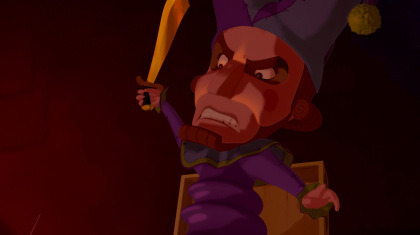
“MUST. CHOP. EVERYTHING!!!”
The jack-in-the-box and the soldier duke it out for a bit before the former sends the latter flying out the window in a little wooden boat. The boat floats the soldier into the sewers and attracts a horde of angry rats who attack him, because animated rodents seem to have a natural hatred towards toy soldiers.

Case in point.
The soldier hurtles into the sea where he’s eaten by a fish – which is caught the following morning, packed up to be sold at market, bought by the cook who works at the very house he came from, and he falls out of the fish’s mouth on the floor where his owner finds him and places him back with the rest of the toys. Now the story this is based on hints that the jack-in-the-box is really a goblin who orchestrates the soldier’s misfortunes with his malicious magic. But based the extremely coincidental circumstances of his return home, I’d say the soldier’s the one who’s got some reality-warping tricks up his sleeve.
The soldier and jack-in-the-box duel again that evening, but this time the harlequin harasser falls into the fireplace and burns up. Our hero gets the girl and lives happily ever after. A nice conclusion, though a far cry from what happened in the original tale: the ballerina is knocked into the fire, the soldier jumps in after her, and all that remains of them by morning is some melted tin in the shape of a heart. I gotta say, for all my love of classic fairytales, Disney made the right call. Andersen’s life was far from magical and it reflected in his stories, making many of them depressing for no good reason. The triumphant note the music ends on also would have clashed horribly if they stuck with the original. Even the Queen of Denmark agreed with Disney’s decision to soften their adaptations of Andersen’s work. I don’t know if I’d call The Steadfast Tin Soldier one of my very favorite parts of Fantasia 2000, but in the end, s’all right.
Carnival of the Animals: Finale – Camille Sant-Saëns
This shortest of shorts (clocking in at less than two minutes) kicks off with James Earl Jones asking with as much seriousness as he can muster from the situation, what would happen if you gave a yo-yo to a flock of flamingos?
The answer –

Good answer!
Fie on those who dismiss this part as a silly one-off that doesn’t belong here. Fie, I say! It’s a pure delight full of fun expressions and fluid fast-paced action. Once again we have my man Eric Goldberg to thank for this, though this time he animated it entirely by himself. I’d call it a one-man show except for the fact that his wife Susan handpainted the entire thing with watercolor, making it look like it sprung to life straight from a paintbrush. It’s a simple diversion about a flamingo who wants to play with his yo-yo while the other snooty members of his flock try to force him to conform. As you can see from the still, they fail quite epically. Nothing beats the power of nonconformity and yo-yos (also every yo-yo move featured here is authentic; I love when animators go that extra mile).
The Sorcerer’s Apprentice plays next, but since I already touched on that in the first Fantasia review, I’m skipping over it. The segment ends with Mickey congratulating Leopold Stokowski (again), then crossing the barriers of time and space to inform the conductor, James Levine, that he needs to track down the star of the next segment, Donald Duck. Levine stalls by explaining a bit about what’s to come while Mickey frantically searches for his errant costar. The surround sound sells the notion of him moving around the back of the theater accidentally causing mischief all the while. Thankfully, Donald is found and the sequence commences.
Pomp and Circumstance – Edward Elgar
This famous piece of music was included at the insistence of Michael Eisner after he attended his son’s graduation ceremony. He wanted to feature a song that everyone was already familiar with. Of course, since this was after Frank Well’s untimely passing and no one was bold enough to temper Eisner’s worst instincts with common sense, his original pitch had every animated couple Disney created up to that point marching on to Noah’s Ark – and then marching out with their babies.
youtube
Okay, A: Unless you’re doing a groin hit joke or are Ralph Bakshi or R. Crum, cartoon characters don’t have junk as a rule. And B, one of the unwritten rules of Disney animation is that barring kids that already exist like the titular 101 Dalmatians or Duchess’ kittens, the established canon couples do not in any official capacity have children.

To which Eisner laughed maniacally and vowed that they would.
But in order to placate Eisner’s desire to turn every branch of the Disney corporation into a commercial for itself, the animators compromised and agreed to do Pomp and Circumstance with the Noah’s Ark theme, BUT with only one couple – Donald and Daisy Duck. In this retelling of the biblical tale, Donald acts as Noah’s beleaguered assistant (I guess Shem, Ham, and Japheth were too busy rounding up the endangered species). Daisy provides emotional support while preparing to move on to the ark as well. It’s refreshing to see these two not losing their temper at each other for a change. I wish we got to see this side of their relationship more often. Donald returns Daisy’s easily lost plot device locket to her and as the rain rain rain comes down down down, he starts directing the animals on board; the lions, the tigers, the bears, the…ducks?
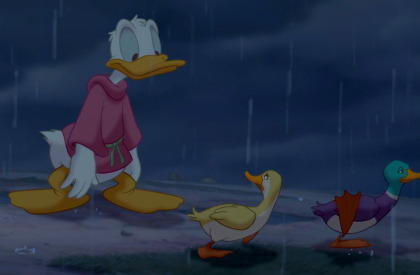
Anyway, all the animals and Donald get on board – well, most of them do.
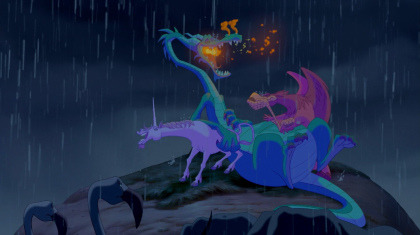
The world’s first climate change deniers.
Donald realizes Daisy hasn’t arrived yet and runs out to look for her, unaware that she’s already boarded. Daisy sees Donald leaving but is too late to stop him before the first floodwaters hit their home. Donald made it back to the ark in time, however, though both of them believe that the other is forever lost to them. I find it astounding that they never run into each other not even once during the forty days and forty nights they’re cooped up on that boat. It’s the American Tail cliche all over again, and well, at least it’s happening in a short and not the entire movie.
Soon the ark lands atop Mount Ararat and the animals depart in greater numbers than when they embarked on their singles cruise. Daisy realizes halfway down the mountain that she’s lost her locket again, which Donald finds at that very moment while sweeping up, and the two are joyously reunited.

“I thought you were dead!” “I thought YOU were dead!”
I kid around, but I truly enjoy this short a lot. There’s so much warmth to Donald and Daisy’s relationship that makes their reunion at the end all the sweeter, and there’s plenty of great slapstick to offset the drama in the meantime. I will admit it’s nice to hear there’s more to Pomp And Circumstance than just the famous march, and the entire suite matches flawlessly with the visuals, though the main theme itself is so ingrained into the public consciousness that it’s difficult to extricate it from that what we’ve seen accompany it countless times.
Come on, you all know what I’m talking about.
youtube
“What? Don’t tell me YOU don’t think of heads exploding like fireworks when you hear Pomp and Circumstance! Name one other life-changing moment could you possibly associate it with…you weirdo.”
The Firebird Suite – Igor Stravinsky
Fantasia 2000 comes to a close with a piece that has some emotional resonance if you know your history. You might remember from my first Fantasia review that Igor Stravinsky was disappointed with how Rite of Spring turned out, especially since he was a big admirer of Walt Disney and really wanted to do more projects with him beforehand. I don’t think it’s a coincidence that they picked his premiere ballet to end the movie on decades later. After all these years, Disney worked hard to do right by Stravinsky – with a few twists, though. Instead of a balletic retelling of Russian folktales involving kidnapped princesses and immortal sorcerers, we have a fantastical allegory for the circle of life.
No, not that circle of life.
A lone elk who I’m fairly convinced is the Great Prince of the Forest walks through the forest in the dead of winter. With his breath, he awakens the spirit of the woods and one of the most beautiful characters Disney has ever created, the Spring Sprite.

I. Love. This character. Her design is gorgeous, shifting from a shimmery opalescent blue as she steps out of the water into an eternally flowing fount of live greenery spreading from her hair in her wake. Wherever she moves, grass, flowers, and trees blossom, fulfilling the idea of a springtime goddess more than Disney’s own Goddess of Spring ever did. The Sprite was a massive influence in developing my art style, particularly in her face and expressive eyes, and I used to draw her a lot. Visit any relative of mine and chances are you’ll find a picture of her by me hanging up on a wall somewhere in their house. Yet there’s far more to her character than just a pretty representation of nature; there’s plenty of curiosity, spunk, determination, and a drive for creativity. I love her frustrated expression when she’s dissatisfied with the tiny flower she sculpts out of the ground and how her face lights up when she morphs it into a buttercup as tall as she is.
The Sprite paints the forest with all the colors of the wind (mostly green) until she reaches a mountain that isn’t affected by her magic. Perplexed, she climbs it until she finds a large hunched over rock figure – or is it an egg? – standing inside. She reaches out to touch it and…
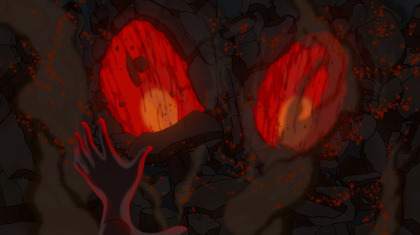

The Sprite has awakened her counterpart, the wrathful and deadly Firebird. Think giant evil phoenix made of smoke, flame and lava. And it goes without saying that seeing this on the biggest screen left quite the terrifying impact. One of the biggest inspirations for this sequence was the eruption of Mount St. Helens (though the shot of the Sprite surveying the breadth of the Firebird’s destruction reminds me far too much of the Australian bushfires going on) and the sheer horror of nature’s irrepressible chaos is fully captured here. But the Firebird refuses to settle for merely destroying the Sprite’s handiwork, oh no. It won’t rest until creation itself is consumed, and the Sprite is reduced to a powerless mite as she scrabbles to escape the Firebird’s relentless pursuit of her. Try as she might, however, the towering monster corners and devours her in one fell swoop.
The forest is reduced to gray ashes in the wake of the Firebird’s rampage, but the Great Prince has survived. Once again he brings the Sprite to life with his breath, only this time she is tiny and weak (the animation of her slowly developing from the ash into her huddled ragged form is breathtaking). Now, I didn’t think I’d get emotional revisiting a small part of a single movie I’ve rewatched countless times before but viewing this through a mature eye combined with the beauty of the Firebird Suite’s climax and its timely message has caused me to see it in a new light:
The Sprite is utterly broken by what she’s been through and the destruction she carelessly caused. She’s lost all faith in herself and in the idea of returning the forest to what it once was. Even so, the Prince gently insists on carrying her on his antlers to the remains of their favorite cherry blossom tree. Where her tears fall, grass shoots begin to sprout. This fills the Sprite with hope, and she soars into the air becoming one with the sky and rains life down on the forest. New trees burst from the earth. The air is filled with leaves and pollen and new life flowing from her essence. The Sprite’s joy and power grow so strong that she even encircles the Firebird’s mountain in all her verdant glory. Life and creation overcome death and destruction. It’s not Night on Bald Mountain/Ave Maria, but it’s close.
And unfortunately, that’s the biggest problem Fantasia 2000 has.
While working on the original Fantasia, a storyman made the mistake of referring to the work they were doing in “the cartoon medium” in Walt’s presence. Walt turned on him and snapped “This is NOT ‘the cartoon medium’. It should not be limited to cartoons. We have worlds to conquer.”

And conquer they did…just not the way Walt intended.
The point I’m trying to make is Walt was breaking new ground and experimenting with things nobody ever tried when it came to Fantasia. While those risks were initially deemed a failure, it eventually gained the recognition it deserved from the animation and filmmaking community. Any attempt to recreate the magic of Fantasia is no small feat. But rather than taking new risks that not even the first film dared, the studio opted to adhere to Fantasia’s formula with pieces that recall if not flat out copy from the original segments. I hesitate to call it a pale imitation or cash grab however because this was done for the art much more than the money (though Eisner was probably hoping it would bring in some bank). There’s even a little bit of depth to it: while the first Fantasia had themes of differing natures in conflict – light vs. dark, fire vs. water, etc. – Fantasia 2000’s theme is accidental but brilliantly meta: CGI vs. traditional animation, a conflict Disney would become very familiar with in the decade following the film’s release. In some ways, it reminds me of Epcot’s genesis. The driving force behind it was long gone, but the attempt to bring it to life as close to the original vision as possible is still much appreciated.
For all my gripes, I really do enjoy Fantasia 2000. Perhaps not on the same level as its predecessor, but it has its moments, oh yes. And believe me, as far as Disney sequels go, you could do far, far, far worse than this one. Fantasia 2000 is Fantasia’s kid sister mimicking its beloved older sibling in an attempt to show it can be cool like the big kids too. But hey, imitation is the sincerest form of flattery.
Thank you for reading! If you enjoyed this review, please consider supporting this misfit on Patreon. Patreon supporters receive great perks such as extra votes for movie reviews, movie requests, early sneak-peeks and more! If I can hit my goal of $100 a month, I can go back to weekly tv series reviews. As of now, I’m only $20 away! Special thanks to Amelia Jones, Gordhan Rajani and Sam Minden for their contributions! I’ll see you in a few weeks when I and review the 1959 Disney animated classic, Sleeping Beauty!
Artwork by Charles Moss.
Screencaps from animationscreencaps.com
Yes, I know The Lion King and Lady and the Tramp ended with the titular characters having babies, but was there anyone out there apart from Eisner who demanded there be sequels to those films that focused on their offspring?
January Review: Fantasia 2000 Last year I talked about Fantasia, which is not just one of my favorite Disney movies, but one of my favorite movies in general.
#2000#2000&039;s#2D animation#action#al hirschfeld#angela lansbury#animated#animated feature#animated movie#animated movie review#animated musical#animated short#animated shorts#animation#animator#animators#anthropomorphic animals#art#ballerina#Beethoven#bette midler#brave tin soldier#Camille Saint-Saëns#Carnival of Animals#Carnival of the Animals#carnival of the animals finale#cgi animation#computer animation#continuation#continued
1 note
·
View note
Text
Shin Megami Tensei
(Definitely part 3 of a series of posts on the entire franchise)
For the end of MegaTen II, Atlus pulled out all the stops in terms of who you'd meet and what their importance to the lore was. While the ending arguably did leave some room for further escalation, by choosing to continue the story as it was, they'd be agreeing to keep being derivative works in relation to the books that originated their backstory. Sure, it was hardly the case anymore, what with the extreme departures MegaTen II took from the novels, but still. I guess the relative corner the writers got themselves backed into, combined with the clamor to have a more independent franchise on their hands, prompted them to scrap their established continuity and kick off a new one of their own. Whatever the real case was, it was definitely a smart choice, and thus was born Shin Megami Tensei, a way for them to keep their profitable series going. Also probably a much better game than a MegaTen III would have been.
Anyway, with a new continuity, possibilities were endless. They could better retread grounds they had already covered in the previous two games (well, really just MTII, since the first one barely even had anything going on), and expand upon ongoing themes while not having to worry about the usual expectation for a sequel in terms of magnitude and impact. Given that, it's unsurprising that, in comparison to MTII, this game dials things down a notch, relegating most of the more classical power fantasy stuff to the third act and preferring to engage in more character-driven events while leading up to it. None of the final enemies in SMT are as powerful as the ones in MTI and II (in story terms, actual battle stats notwithstanding) and the influence of cosmic forces that would have been enemies fought directly in the titles so far takes on a distant, more psychological approach (for the most part), unable to be challenged by the player. This helps build them as respectable overarching threats, and keeps the setting more subdued and the stakes higher, since it feels like characters are acting under the banner of things so powerful the player shouldn't even think themselves able to scratch them. It's good not to stat things sometimes, and it's quite impressive that they exercised this restraint way back in 1992.
For the demons that ARE fought, though, the artists really put their all into it this time. Even compared to games in the series's near future, I think this is the best looking they would be for a while. I mean, sure, Majin Tensei later on would have more detailed graphics, but I feel the art itself was worse there, with some weird proportions and a lot of palette swaps, while this game keeps things more consistently good overall.
Naturally, one longstanding tradition of the franchise introduced in SMT was the philosophical axis of Law vs. Chaos and the branching story that allowed the player to sit in any one point of the spectrum, with a modified final act depending on your decisions up to a certain point and where in the axis they would leave you once this point is reached. This system was partly a logical progression of the two endings from MTII and partly a way to integrate gameplay significance into what was already the grand point of SMT's storyline. While a good idea on paper and certainly innovative for its time and context, the warring faction-based story meant that as far as the plot is concerned, Law vs. Chaos pertains more to which of the factions you're appeasing with your decisions rather than any particularly lawful or chaotic behavior. There are some things that shift your alignment that have to do with being lawful or chaotic, but those lie mostly outside of the plot, in small actions that only serve to bring things one way or the other on infinitesimal increments and are meant more as an extra level of thought put into the system to label certain actions that were always there. The parallelisms between one faction and the other (i.e. temples that are identical in functionality; quests that consist of killing the other faction's quest-giver or vice-versa), together with certain easily exploitable ways to shift the alignment variable any way you want (so that you can play the game being entirely chaotic up to the crucial point where your alignment is locked, then right before that, exploit the mechanics to bring yourself to Law without having done anything lawful throughout the rest of the game), make the whole alignment system feel arbitrary, or at least the actual coded-in gameplay layer of it. I feel like maybe having only the unrepeatable story decisions actually affect alignment could help mitigate this somewhat. Then again, as I said, the story stuff doesn't feel much like the player being lawful or chaotic, so... I don't know.
Regardless of which path you take, you are going to get into a lot of fights. The game plays basically exactly like MTII, with an overhead top-down overworld and first-person dungeon crawling once you enter an area. This time around, very few areas are safe from enemy encounters, which makes sense since you're mostly just walking around Tokyo and a lot of first-person areas are just sections of the city that are populated (and besides, all of Tokyo is under threat from the demons). It made me realize that it's actually the typical RPG that opts to be nonsensical about the no-monsters-in-towns rule, but I'd be damned if that's not a smart choice on the part of the typical RPG. There are so many random encounters in this game, it's a common occurence for you to get several 1-step fights in a row. When I play an RPG, there's usually a point where I get really bored of always fighting enemies, then I finally escape the dungeon I'm in or go into a town and it's a big relief, like I can finally walk around and talk to people without having to stop dead in my tracks to fight the same enemy I already proved I can beat five hundred times before. Not so much in this game, and you'll definitely be crying out for an Estoma or a Fuma Bell most of the time. If you even know these two things act like repels in Pokémon and realize how useful they are.
If you don't know, however, you're going to need a lot of patience, because once again the game is very easy. Aside from, once again, a difficult earlygame, especially if you didn't put the right stat points into your protagonist (read: vitality and speed), the same basic problems from the previous two games' core concept of walking around and fighting dudes can be found here, but this time guns have ammo. Ammo doesn't actually count how many bullets you have left, it's just an extra thing you can equip that gives your gun attack an extra property such as more damage or a status effect. Thing is, status effects have an absurdly high hit rate in this game, work on most bosses, and there's a type of ammo that causes the "enthralled" status effect, which makes the target attack their own allies. Once you've got your hands on it, the game has been effectively turned into an interactive movie, even easier than the NES ones. Even without it, magic always seems to go before physical attacks, and both lightning and ice spells can stop an enemy for the current turn, so you'll likely always find a way to trivialize encounters within your disposal if you're just playing the game normally, even if you didn't realize it. With good speed, lightning or ice spells at your disposal and some status effect ammo, nothing will ever be able to stop you, no matter how hard they try. Once again, it's a preparations game, and that auto-battle button will get an intense workout this time around. I actually cleared the entire final dungeon under the effect of consecutive Fuma Bells, because of the combined effect a high encounter rate and the knowledge that the bosses could not stop me had on my brain. It's all about knowing which things are actually useful and which aren't, so it's actually just about struggling until the point you figure it out, then blazing through the game's fights half-asleep.
Still, battles notwithstanding, I think the exploration is more masterful than ever this time around. There isn't any significant portion of the game where you're clearly going after McGuffins, the whole story is pretty tightly paced and the balance between open-endedness and plot progression is well kept. There is a clearly evolving status quo for the entire setting of the game, and each time a major change happens new areas are made available while others are locked away. You can feel the effect the events of the narrative are having on the whole scenario, and the progression creates a bit of a disorienting effect as you attempt to find your way to the next significant location (which can and very well may cause you to get hopelessly lost on occasion, but that's part of the experience, I think). It's a pretty admirable blend of elements working together to create a continuous experience. This bleeds over into the characters themselves, who have evolving arcs and, for the most part, continue to be relevant and to have all sorts of crazy things happen to them through the course of the game. Consider it a much more mature attempt to do the sort of character-based revolving scheme that Final Fantasy IV also tried to do.
Overall, this is a game that further plays around with story concept brought over from MTII, experiments somewhat with new ways to go through some of its story beats, and creates a character-based narrative that goes through admirable amounts of change, to the point you can feel the whole cast working through their arcs as things escalate and reach a fever pitch. The gameplay is significantly less refined, though, and, admittedly, even the respectable things in SMT have struggled to stand the test of time, especially when you consider what later SMTs and SMT spinoffs would go on to do. I think this earns the original a 6.5 out of 10, my first non-integer score. It's damn respectable and admirable for 1992, but it has so many outdated things in it that it's hard to actually get oneself into the proper mentality to admire it unless you actually make the conscious decision to play the series in chronological release order. But who would be masochistic enough to do that, right?
3 notes
·
View notes
Text
Costume: The Language of Fashion
Welcome to the unending Knot! As we put together for Halloween, lets take a appear on the customized of costumes. Costume and customized are eventually the identical word, costume being only the custom of how one dresses, however these two varieties of the phrase got here into English by way of extraordinary paths. Each are from Latin consuetudo which means custom, dependancy tracing its source back to a Proto-Indo-European root which means oneself, which also offers us the words self, suicide (killing oneself), idiom (ones possess means), and ethnic (a band of people dwelling together). At bottom, then, costumes and customs are approaches we outline ourselves. So Im going to take a seem at one of the most language of fashion, and also at how trend can perform as a language, communicating your status, background, identity and more to the arena round you. Customized came into English first, in the 13th century, through Anglo-Norman French within the feel of ordinary apply. Costume however came by means of Italian after which French to arrive in English within the seventeenth century as a technical time period within the quality arts to consult the type of portray or sculpture of a unique historical period.
Costume step by step came to refer to garb rather, now not handiest in the basic experience (as in bathing costume), but in addition the specialized feel of apparel of a special tradition or time (think custom), as in a national costume. Of course the feel of costume we are inclined to believe of first is the outfit worn for specific events reminiscent of Halloween, Mardi Gras, or a fancy gown celebration. A further contemporary phenomenon is cosplay, a eastern portmanteau of the English phrases costume and play, where contributors dress up to recreate characters from a sort of media including comics, video video games and films. Cosplay is extra than just hanging on a dressing up, thoughit has developed right into a highly complex tradition with specified subgroups, in which the choice and variety of costume indicators allegiance to a certain fandom, may also be an outlet for creativity and for difficult stereotypes and cultural norms, and also can point out facets of your price method to different contributors of the group.
However its no longer simplest what we think of as costumes that can participate in this operate. Fashion has continuously been principal in marking ingroups and outgroups, equivalent to whether youre a part of a unique social, religious, or political motion, if you happen to belong to a unique subculture, or effectively how cool you’re. One severe example of this is the macaroni. In and across the 18th century it used to be fashionable for younger guys of way to go on the so-referred to as Grand Tour to Europe to absorb the finer features of European culture and history. Within the 1760s a bunch of such vacationers grew to be enamoured of Italian tradition, as a result the macaroni membership, and took to carrying outlandishly exaggerated patterns of apparel and fashion, with bright colours, much lace, gold embroidery, and comically oversized wigs.
In succeeding generations there was once both an outgrowth and a backlash to this trend known as dandyism, led partly by way of essentially the most noted dandy Beau Brummell, which used to be equally obsessive about matters of sort, however as an alternative moved closer to a incredibly refined look with dark colours, exquisitely tailored clothes, long trousers instead of breeches, and difficult neckties. This kind set the trend for the formal mens go well with that we still know at present. These trend traits grew to be immortalized within the track Yankee Doodle, wherein the uncouth American, most likely not part of the ingroup, rides into city on a pony as an alternative than a horse, and considers the mere ornament of a feather in his cap adequate to qualify him as macaroni making him a Yankee Doodle dandy! Now, its no accident that costume and custom come from the same root, as we are able to inform by means of watching at a parallel pair of words, habit and addiction. That is, dependancy meaning custom and dependancy that means clothing, as in a nuns dependancy. The phrase, which etymologically means what one has, comes by way of French from the Latin verb habeo that means to have.
Both the English addiction and the Latin habitus might refer to the outside, so ones appearance or in different words garb, and to ones interior or persona, and from this develops the feel of ordinary behaviour. Latin habeo goes back to a Proto-Indo-European root this means that to provide, acquire (observe the reciprocal nature of this phrase), and correctly gives us the phrase give, though fairly not the phrase have, although the 2 roots do share a an identical semantic development indeed behaviour, concerning have, mirrors addiction within the sense of routine action. While the word dependancy used to consult clothing frequently, today its customarily restricted to the apparel of monks and nuns.
Another detail of a nuns dependancy that used to be fashioned to ladies mostly was the wimple, a form of material that covered the pinnacle and neck as much as the chin, as it was once viewed immodest for a lady to show her hair. Of course trend changes and the wimple was once dropped by means of every person except nuns, and instead different adornments had been observed for the necks of females, such because the gorget or gorgias, a style of throat protecting which derives its name from the French phrase for throat. This new apparel used to be considered so fashionable that we get the word gorgeous from it. Unless you consider the alternate conception that the phrase is a reference to the Greek thinker Gorgias who used to be apparently really into luxurious and displaying it off.
He was mainly recognized for praise rhetoric and wrote a reward piece for Helen of Troy, whose gorgeousness kicked off the Trojan conflict, exonerating her from any blame. A further neck masking that became standard within the later core ages and early today’s durations was once St Audreys lace, so known as in view that it used to be offered at St Audreys fair. St Audrey, or to offer the long-established Anglo-Saxon variant of her name thelthryth, used to experience necklaces in her early life, and when later in life she bought a horrible tumour on her neck, she took it as divine retribution for her self-importance, a story acknowledged through the Venerable Bede in his Ecclesiastical historical past of the English persons. So i suppose these St Audreys laces have been thought of as modesty preservers. Best as soon as again, trend alterations and by the 17th century these laces came to be inspiration of as inexpensive and gaudy, and so St Audrey used to be shortened to our pejorative phrase tawdry. Bad Audrey, what a legacy! But getting back to those wimples, the source of the word wimple will not be distinct, however it’ll come from a Proto-Indo-European root this means that to turn (as in a cloth wrapped around the head), a root which also gives us the words wipe, whip, and vibrate.
This root additionally gives us the word gimp. No no longer that gimp, however a kind of braided twine used for trimming fabric and in lace–like St Audreys lace, I suppose. Although speakme of that other type of gimp (to not mention whips i assume), this would remind us of yet another part of fashion, apparel fetishes, though perhaps the less stated about that the simpler, notably within the context of nuns! Getting back to these nuns, at the same time they had been covering their hair for modesty, the monks were doings whatever altogether distinct with theirs.
Tonsure, from the Latin for barber, is the shaving of some part of the hair in order to exhibit religious devotion. Extraordinary devout traditions have different patterns of shaving, like for illustration in the Roman church where the very prime of the top is shaved. The Irish church within the medieval period, alternatively, had another pattern of tonsure, a point of so much competition. Certainly the Venerable Bede (don’t forget he wrote about Saint Audrey) connects this difference to the corresponding change between the Roman and Irish approaches of calculating Easter, and the fine climactic second of victory in his historical past is when the English definitively adopt the Roman practise over the Irish. An instance the place coiffure rather did make a decision ingroup and outgroup! No person now really knows what that Irish tonsure used to be like as descriptions are vague, however one suggestion is that the hair was shaved at the front ear to ear however allowed to grow at the back.
So business within the front, celebration within the again? Genuinely there may be a different candidate for the medieval mullet. In the 6th century Procopius wrote of this coiffure in Constantinople where it used to be known as the Hunnic appear. Incidentally, the modern day word mullet for the hairstyle seems to go back best to the Beastie Boys 1994 tune Mullet Head, although some sources additionally point to the 1967 movie Cool Hand Luke wherein the time period mullet head is used, though its not absolutely clear that this is a reference to shaggy hair. The expression mullet head goes again to the 19th century within the feel a silly individual, and springs from the fish mullet, whose title can most likely be traced again to a root that means black. So clearly hairstyle like garb is an essential marker of fashion and thus costume and custom. There had been of path many top notch hairstyles over time, many with fascinating etymologies.
Famous might be are sideburns, named after the the united states Civil warfare normal Ambrose Burnside. Within the seventeenth century when King Louis XIV of France started to lose his hair very likely as a result of syphilis, his donning of a wig kicked off a trend for wigs. Even folks who werent thinning on prime began to put on them. That is what we could now call a celeb fashion pattern. A equivalent trend trend sparked through sickness round that equal time was once the fashion for wearing synthetic beauty marks, at first to hide scars left through smallpox, however soon as a fashionable item in itself. An additional superstar hair fashion was once the pompadour, named in honour of Madame de Pompadour, mistress of Louis the XV. This trend trend would ultimately return some 200 years later on the heads of the greasers in Nineteen Fifties the united states, most famously exemplified by way of Elvis Presley. Well developments do come and go. Of direction clothing as a marker of tradition has been around ever on the grounds that it moved beyond the in basic terms realistic, however the swiftly moving fashion pattern had to wait except the late core a long time and early modern day period to relatively take off. Official tailors commenced to appear in Europe in the 14th century.
And although the button had been round when you consider that ancient instances, believe or no longer it wasnt unless the thirteenth century in Germany that the buttonhole was once invented, permitting the button for use as a fastener. Both of these traits, the tailor and the button, resulted in extra form fitting garb, as a substitute than the loosely draped type of earlier eras, and this used to be the real impetus for trend trends. Moderate variants in reduce and form would exchange quickly, going inside and outside of type. Maybe the primary first-class runaway trend craze is slashing, in which cuts are made in an outer garment to disclose the lavish materials of the garments underneath. This development began off with Swiss squaddies, after defeating the forces of Charles the bold, duke of Burgundy, threading bits of material taken from the tents and banners of their enemies by means of the holes in their possess ragged clothing.
After they again home, the kind caught on and soon unfold by way of Europe. This displaying off of additional fabric is an example of conspicuous consumption, essentially showing off your wealth, like the prominently displayed fashion designer trademarks of at present. Of path to be competent to show off by means of clothing you had to be of the higher classes. Actually throughout the core ages and early present day interval, legal guidelines have been handed to prevent curb class men and women from dressing above their stage.
You see right now there used to be the upward thrust of the middle type all of a sudden non-nobles had disposable earnings, made out of alternate and manufacture as an alternative than the land owning of the noble classes. So these so-referred to as sumptuary legal guidelines have been handed proscribing what people might wear at one of a kind levels of society. This wasnt of direction the first time such restrictions existed. In ancient Rome, for example, best Roman citizens, in different words free-born Roman men, were allowed to wear togas. It used to be a marker of repute and rank. I someway dont think these Romans would approve of the toga celebration! Speaking of which, that institution tradition started it appears in 1953 at Pomona tuition, and later grew to be noted within the movie country wide Lampoons Animal residence. Nevertheless, before this there is a narrative of First girl Eleanor Roosevelt throwing a toga party to spoof the criticism of her husband FDR as being like a Caesar. As soon as once more, the politics of trend. As for apparel as a marker of repute, even after those sumptuary laws were dropped, it wasnt relatively unless the advent of competent-to-wear clothing, with standardized sizing that you would purchase off the rack with out want of tailoring, that fashion really started to be democratized.
Eventually the center category could be trendy as well. Despite the fact that those outstanding clothier trademarks of today, and the whole haute-couture world, show us that fashion and status are quite still a factor. Getting back to France, the dwelling of trend, a further fashion-setting elite used to be Marie Antoinette, spouse of King Louis XVI, who is the ultimate illustration of excessive extravagance.
It seems that she preferred being known as the queen of trend to the queen of France. Her designer Rose Bertin, who is the primary noted fashion clothier, created the trend doll as a way to disseminate the in trends to Marie Antoinettes loved ones and friends, and this was form of a precursor to the fashion magazine as we know it at present. Really the very first fashion publication was once Castilgliones The guide of the Courtier from the early 16th century, which dealt with etiquette at court docket. The magazine Mercure Galant from the late seventeenth century began to offer advice concerning the trendy tendencies, and by means of the late 18th and early nineteenth century there have been numerous such publications in general with trend plates demonstrating the styles. Marie Antoinettes successor as fashion pattern setter was once the Empress Josephine, wife of Napoleon Bonaparte. Rejecting the lavish styles of Marie, Josephine took a web page from the neoclassical developments of the day and wore attire an identical in variety to the peplos of old Greek females, cinched excessive above the waist.
We now comprehend of this because the empire waist in honour of Empress Josephine. Additionally to being belted on the waist, the old Greek peplos used to be fixed on the shoulders with broaches often called fibulae. Without a doubt the fibula is similar to the modern day defense pin. The protection pin was reinvented in ultra-modern instances by using a man named Walter Hunt, whose other important fashion declare to fame is inventing the lockstitch mechanism that makes the stitching desktop viable. The stitching machine is honestly the mixed work of a number of different inventors coming together. The one to quite make it sensible, viable, and popular was Isaac Singer, who put into practise the today’s manufacturing facility creation approaches to mass produce the machines. Singer was subsequently sued for the patent by way of inventor Elias Howe, who had designed his own lockstitch mechanism, Walter Hunt having declined to patent the thought as he used to be afraid it might put seamstresses out of labor.
But in the end, it was Singers stitching machine that helped to democratize trend, not best making manufacturing of garments more cost-effective and less complicated, however making it possible to do the work in the home. As for Elias Howe, his other fashion claim to status is developing with the primary automatic, steady clothing closure in different phrases the zipper. Unusually, Howe made so much money from his lawsuit in opposition to Singer that he on no account stricken to market his zipper, and it wasnt until the thought used to be later reinvented by way of Whitcomb L. Judson at the finish of the nineteenth century and additional developed by using Gideon Sundback that the general public got the zipper as we know it today.
Incidentally, the word zipper initially talked about the boot it was once designed for, no longer the fastener itself, but the term soon transferred over. At present the zipper is the fastener of alternative on many other forms of garb, such as jackets and probably on trousers, besides on buttonfly denims, the place the button remains as a quaint holdover of days previous. Speaking of jeans, this staple of brand new trend was invented for the nineteenth century gold rush, as the miners wanted tough durable trousers for working in. The tailor Jacob Davis had the proposal of setting up trousers with rivets to make stronger the seams. He bought the hard denim material from wholesaler Levi Strauss, and eventually the 2 went into trade collectively, and Levi denim denims were born. However the language of this fashion predate this invention and is derived from far afield. Jean is an ancient sixteenth century word that comes from the city identify Genoa, and came to consult a rugged variety of fabric that came from there.
The word denim is derived from the French de Nmes meaning from Nmes, a city in southern France. And to high it off, dungaree, one other identify for jeans, comes from the identify of a village in India, Dungri. So this icon of american fashion actually comes from far and wide the sector! And indeed as the globalized 20th and 21st centuries have become more and more fragmented and uncentred we can now not speak a few single trend, and there are some distance too many trends, styles and subcultures to say right here. But probably one of the most hanging that borrows from the prior is the goth style.
Combining retro Victorian patterns with the gloominess of gothic horror fiction, the development used to be taken up via these feeling isolated from and wishing to rebel in opposition to mainstream tradition. And that brings us properly back to Halloween costumes. There seem to be a quantity of traditions that contributed to dressing up in costumes at Halloweenwhich I discussed in some element in my video on Jack-o-Lantern. One part of this practice is that it offers licence to misrule, dressing up in taboo costumes, and breaking average social boundaries. In additional latest years there’s the unfortunate pattern of dressing up in the (regularly stereotyped or caricatured) country wide costumes of other cultures, decreasing these cultures to a type of costume that may be placed on via any individual. Additionally theres the sexualized costumes, chiefly where it creates a pointy contrast, as within the attractive nun costumes. Far from that modest wimple! If trend is a language, might be we should feel about what we’re saying with these costumesand no longer make a habit of it! Thanks for observing! If youve loved these etymological explorations and cultural connections, please subscribe to this channel or share it; you can also signal up for electronic mail notifications of recent videos within the description under.
And verify out our Patreon web page, where which you can make a contribution to help me make more videos go away a remark or query, or tweet @Alliterative; which you could additionally read more of my thoughts on my web publication at alliterative.Internet .
.fb_iframe_widget_fluid_desktop iframe { width: 100% !important; }
Tweet
Source: https://skullssales.com/
1 note
·
View note
Text
Mad Titan, Or Last Man

Please note that this is an incomplete assessment of motivations simply because comic book characters will never have an end to their story. I am also not informed on Thanos’ current exploits in the comics since I have not read Marvel, or any comics for a number of years. The focus will be on an older iteration of Thanos and his fascination with death that I believe derived from him growing up in a utopia of immortals essentially. Also, this is not an explanation of the Hollywood version of Thanos since his motivations make no sense and is clearly just political propaganda from writers that don’t know anything about population trends. This is not a super in-depth analysis either, I’ve merely looked at his motivations through the lens of the Nietzschean last man, as well as the underground man from Dostoevsky's works.
I had difficulty understanding it at first, mostly because I personalized concepts too much that I shouldn’t have, namely Lady Death. Which in turn, made Thanos’ motivations look like an outburst of an angsty teenage boy. You can’t fully personalize a concept in a story otherwise you miss the point, Lady Death is still death itself, the only real reason it was given form is because that’s seems to be the easiest way to relate to values expressed in stories; it makes it easier to embody them through secondary personalization, which is a term coined by the psychologist Eric Neumann. Secondary personalization is an act from which the more something is understood, the more it is refined in the consciousness until it’s anthropomorphised completely, creating almost a god image within the individual. It’s essentially the same as the image of Helen of Troy discovered by Faust when he travels to the realm of the mothers, she was the spirit of unbridled creative generation and freedom that he longed for. Lady Death is the anthropomorphised value of what Thanos desires most, and he expresses it as female because he is male, because it’s that which he lacks, the other part of his reality. That is partly a Jungian notion from which the male takes an inward journey to discover the Anima within, or his inner feminine that is tied to his highest value, making the attaining of that value an almost sexual act of union between being and image, something like that.
“But wait” you may say, “then why is Death a woman to all within the Marvel universe?” Good question, that is because the concept of death has always been a feminine one throughout history; it is the consumptive element of nature that consumes the life that came before so that successive generations may come into being. The easiest picture to express this in is the Ouroboros, the serpent that eats its tail. It is the sphere that contains existence from which death, or consumption is the precursor to new life. Other faces of death are the Babylonian Tiamat, the Malekusian Le-Hev-Hev which translates to “she who draws us in with a smile so she may consume us.” There is also Nut from Egyptian myth, the mother sky who embraces all in death, which you can see her image placed on sarcophagi, and Ta-Urt who is the bestial guardian of the underworld. Death is Feminine because it is part of nature, or the great mother earth, so it’s not surprising that we will portray it as a woman... Most of the time.
For this assessment though, I want to focus on Lady Death as a very singular expression of his “highest art” so to speak, which arised from the stagnancy of Utopianism. So, let’s begin.
What would a man(or eternal) strive for when perfection was already attained? I really needed to think about that for a second because when you think about utopia, the interesting bits are always the struggle to achieve it. That’s where the meat is in such a value system, that’s where all the action is, and that’s when I had an idea. So, what would a man(eternal) strive for when perfection was already attained? Perhaps he would strive for struggle itself. Perhaps when given eternity, what then would be more desirable than the finite? What could you desire more after you are given the universe through society, than to have it all taken away? It sounds crazy doesn’t it, who would ever destroy perfection merely to struggle? Well, a human would... Even in the face of eternal happiness and comfort, simply to achieve one semblance (if even for a moment) of the meaning that comes only from the finite and imperfect, a person would dash it all away.
That is the purpose of Thanos, he craves the one thing that was taken from him by his parents, and the society that believed it knew better, namely death. Honestly, what meaning could you ever possibly find in a world where people have already conquered the most meaningful aspect of it? Things have to die, things have to wear down, they need to decay because the universe isn’t a structured space of rules and laws. It bends, it curves, it’s constantly changing, it’s a flow of perpetual becoming. The speed of light itself is constantly changing, and that is the speed of causality itself, which is the frame from which events can even happen in reality. Laws, structures, immortality are all societal concepts born from consciousness, more precisely the consciousness of the left hemisphere; especially the concept of immortality. Things are always changing, we just cant perceive most of it, and you, are not really you. Everything you are now is the current complexity of a a cosmic lineage that dates back to the very beginning of existence. All the material that makes up your being came from the death of something before you. Whether it be the nutrients you ingest from animals and plants, or the elements of you refined in the cores of long dead stars. You are a process, not an end, and to extricate yourself from that process is to produce a fate far worse than death could ever be, an immortal Utopia.
I had to ask myself, is that really the goal of life, just to transcend it? If like the eternals that happens, what other outcome could you have but a utopia of eternal happiness and complacency? Why would you even want that when what is taken is so much? What other options could you ever have than sacrificing everything that made you human; to place it all at the alter of godhood, so that you could simply keep existing and going through the motions like a machine. There’s a reason why vampires are portrayed as impulsive nihilists most of the time, because what the hell else can you do with eternity once you have it. Of course there is a universe full of possibility within the universe, but it will never be achieved by the eternals because they are no longer part of that process and the only kind progress they can achieve is scientific analytical processes which is very indicative of western culture now, because that’s all they value. Which in turn will probably only lead to them becoming like Celestials, ethereal nothings that don’t exist in reality, that don’t understand the underlying complexity and importance of emotion, and merely act like computers.
That entire society and Thanos himself is a microcosm, most likely of the projected anxiety of a post-industrialized society that puts far too much (to an almost pathological degree) value in a singular system of linear analytical cognitive progress. My god ladies and gentlemen, if eternity was sitting in a lab continually making it easier for people to live for the eternity they have anyway, where all that’s left are mere intellectual and habitual procreative pursuits, I would also think death and destruction would be a far more preferable option, it could even become an ideal. Jesus, just try it for a hundred years and get back to me on how you feel about it. I don’t blame Thanos for pining after it, lusting after it, making it his muse, his companion, the Galatea to his Pygmalion, his reason for being. It’s meaning that matters, not more life, not happiness, not perfection, It’s the meaning in the struggle for more life, it’s the meaning you derive from struggling for happiness, it’s the meaning in life that you derive from struggling for perfection that gives depth to existence. It’s not the result, it’s the process. Death matters because it makes everything beautiful, everything meaningful, everything is something you will never see again, something that will never be again. Struggle matters because it makes you more than what you were, it allows you to change. Now let me talk about struggle more.
To struggle is to be human, to suffer is to truly live. Humans are the only beings that can say life is suffering and have a smile on their face. And humans are the only beings in the known universe that will willfully suffer in full understanding of it. Each person has a vast ocean of dormant potential in them just waiting to be realized. I don’t say that in a metaphorical way, though that’s the best way to describe it. You have a plethora of dormant genes in you that wait for the right environmental factors to be activated and embodied as new modes of being, because humans are action oriented, not cognitive oriented. It’s the notion of wishing upon the stars, each one represents a potentiality of what you could be, and you have a choice, you can pick a star and struggle for it. But if you don’t have to struggle anymore, if you have forever and everything provided for you, you won’t do it, you won’t experience it, because you don’t have to. I say this because Thanos is human, strikingly human, perhaps even the greatest of what humanity could be, essentially he is the underground man in a world of last men.
“I tell you: one must still have chaos in oneself to give birth to a dancing star. Alas! There comes a time when man will no longer give birth to a star. Alas! There comes a time of the most despicable man, who can no longer despise himself. Behold! I show you the last man, ‘What is love? What is longing? What is a star?’ So asks the last man and he blinks. The earth has become small, and on it hops the last man who makes everything small.”
“His species is ineradicable like that of a flea; the last man lives the longest. ‘We have invented happiness’ says the last man, and blink. They have left the regions where it was hard to live for one needs warmth. Becoming sick and being suspicious are sinful to them: One proceeds carefully. He is a fool who still stumbles over stones or human beings!”-Thus Spoke Zarathustra p.13
Of course, it would be very rational to want such an existence, and everyone on his world is very rational, but rational isn’t reasonable, and reasonable isn’t meaningful. People are contradictions unto themselves. They almost never want what they need, or need what they want, or even want what they want. The easy paradisaical life is a beautiful dream full of splendor and joy... Only so long as it stays a dream. If man were to make his dream a reality I believe, well, I know that the moment after he would spit on the very ground he toiled so arduously to build and content himself with its absolute destruction, just so something interesting could happen in his utopia. That is the folly of it, and that’s what I believe Thanos saw, even if he didn’t understand it himself. That is essentially Dostoevsky's notion of utopia and the values of enlightenment which is basically the society the eternals had made.
“There are continually turning up in life moral and rational persons, sages and lovers of humanity to make it their object to live all their lives as morally and rationally as possible, to be, so to speak, a light to their neighbors simply in order to show them that it is possible to live morally and rationally in this world. And yet we all know that sooner or later those people have been false to themselves, playing some queer trick, often a most unseemly one. Now I ask you? What can be expected of man since he is being endowed with such strange qualities? Shower upon him every earthly blessing, drown him in a sea of happiness, so that nothing but bubbles of bliss can be seen on the surface; give him economic prosperity, such that he should have nothing else to do but sleep, eat cakes and busy himself with the continuation of his species, and then out of sheer ingratitude, sheer spite, man will play you some nasty trick. He would even risk his cakes and would deliberately desire the most fatal rubbish, the most uneconomical absurdity, simply to introduce into all of this positive good sense his fatal fantastic element. It is just his fantastic dreams, his vulgar folly that he will desire to retain, simply in order to prove to himself(as though it were so necessary) that men are still men and not keys of a piano, which the laws of nature threaten to control so completely that one will be able to desire nothing but by the calendar. And that is not all: even if man were nothing but a piano key, even if this were proved to him by natural science and mathematics, even then he would not become reasonable, but would purposely do something perverse out of simple ingratitude, simply to gain his point. And if he does not find means he will contrive destruction and chaos, will contrive suffering of all sorts, only to gain his point! He will launch a curse upon the world, and as only man can curse (it is his privilege, the primary distinction between him and other animals), may be by this curse alone he will attain his object- that is, convince himself he is a man and not a piano key! If you say that all this, too, can be calculated and tabulated chaos darkness and curses, so that the mere possibility of calculating it all beforehand would stop it all, and reason would reassert itself, then man would purposely go mad in order to be rid of reason and gain his point!” -Notes From Underground p.230-231
The point I’m expressing is that people are inherently chaotic, and that they love it too, it’s the source of our greatest freedom, the dancing star. We would also destroy all that was good for us merely to keep it. That chaos is lethal to utopianism and eternity. Thanos killed his people and worshiped death because perfection had a flaw, it was meaningless. They sacrificed everything for it, and in turn missed the sole notion powerful enough even to propel one to remake the whole universe and succeed... death. But, that’s just some guys opinion.
7 notes
·
View notes
Text
Sailor Senshi and Shitennou Romance Essay -Introduction
(Warning. Due to the way Tumblr Mobile is working for me there may not be a read more on the mobile version of this essay. I do have one up on the computer version of the program, but apologies for anyone reading this on mobile. I’m still trying to work out how to make this work better for the readers there. I may have to eventually set it up where there’s a mobile only blog…but until then…yeah…still working this all out. )
For those who don’t care about the above, skip down to the info below the picture.
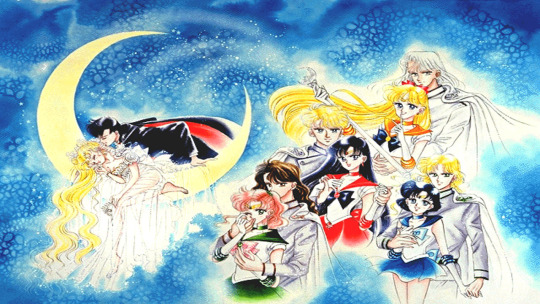
Where to even being with this. I suppose I should start as to why I would even do an analysis on the romances here, given that they were very limited in scope of the story proper. We only really got a quasi-detailed account of Kunzite and Venus from Sailor V and the main Sailor Moon Manga. Yet, it seemed to be that, even despite not being able to write about the romance in her work, (due to either her own issues with writing long works. (Something that Ms. Takauchi has mentioned in interviews before), or the story proper not being able to facilitate a longer narrative for the romantic structure (it’s a Tokusatsu after all)), Ms. Takauchi still seemed to want to have those romances in some way. If you look at her artwork and some later stories –such as Casablanca Lilies and the short story about Sailor Moon’s other child (which is non cannon) –we know that she does have focus on the girls love lives.
For me the most interesting aspect about these possible romances is the way it connects to the older stories from not only the west with Selena and Endymion, which formed the bases of the romance with Usagi and Mamoru, but also the Eastern tales of lost romance. Specifically the story of Tanabata Festival, Princess Kaguya, and possibly the story of the crane wife (usually it has a story with a celestial being falling in love with a mortal man). The reason I’m equating them to these stories is how they end up being both sad yet romantic in some ways and in some cases there are some aspects of a happy ending, within the context of how the Japanese see a happy ending.

For the story of the Crane wife, normally it tells of how a young farmer discovered a woman bathing in a pond and he fell in love with her. He discovered she had a cloak that was magic and took it with him hiding it from her after the woman has fallen in love with him. Eventually after a while of them being married and her having a child with the man, the woman becomes more and more depressed over something. Then one day, either she or her child discovers the robes and changes back leaving the man and the child. Or the man never knew she was a crane or a celestial being and he discovers this one night after coming in on her wearing her robes, and because of this she has to leave his side and return home.

On the flip side is the Princess Kaguya story where she came to earth to learn to be a human, but didn’t want to fall in love, and eventually returns to the moon against her will mostly because the moon goddess missed her.

Finally, you have the story of Tanabata, which is based on an older Chinese story of Qixi. The story goes something like this, there’s a princess named Orihime who is the daughter of the Sky King Tentei and she used to weave clothing on the banks of the Milky way river for her father. So the princess was sad that she could not fall in love because she was always making her dad clothing. Her dad, feeling sorry for her, decided to invite a boy that he knew named Hikoboshi, who was a cowherd that worked on the other side of the river. The two met and fell in love and married. However because they got married and were together all the time both neglected their work, so Tentei ended up splitting them apart. This eventually led to Orihime begging her father to allow them to be together. Tentei was so moved by his daughter’s tears and words that he agreed to let them meet once a year on the 7th day of the 7th month as long as she finished her weaving. As such, the two were going to meet but there was no bridge, but a bunch of magpies created one for her so that she could cross over to him and be happy for a while.
Oddly enough, the story was used in a Chibiusa Picture Diary story, but that’s not where the importance lies.
So how do these three stories fit into the idea of the knights and the Scouts and their romance and why? It’s not uncommon in Japan to rely upon older stories for crafting new stories for Shojo writers. Typically, it can come from the west or the east, but a lot of ideas from the idea of true love tends to derive from older stories and legends that have been passed on, much like western fairytales, and in the case of Sailor moon, a lot of the idea of legends are pulled into a new form. As I mentioned the three stories are an influence in the work, and there are strong hints through Usagi and Mamoru’s romance about their relationship hinting at these three works, along with the Selena story.
You have the idea of the Prince and Princess being from worlds apart, which connect to the legends surrounding the Crane Wife, and partly the tale of Kaguya. More frequently, you have the fact that the two end up with each other for a while, but the celestial being is normally not supposed to be with a mortal human. The Tanabata legend is deeply invested in the story as the two lovers that we see are not only from different places, thus split by the space between them, but their world is pulled apart by the actions of others. In the case of Orihimi and Hikoboshi (Vega and Altair), we see her father break them up via the river that is the Milky way, in the case of Serenity and Endymion, it’s the actions of Queen Beryl that split them apart.

This can also correlate to the other girls in various ways, since we see that they too met with the Knights and fell in love, as per Venus explaining. Which brings up the idea that Ms. Takauchi probably wasn’t just thinking about how the tale pertained to just one person, but how it could affect others who met too and fell in love. This also I have to say brings us to the idea of the Tokusatsu aspect of the series. Most notable is that the Sentai at the time before Sailor moon was created did have an additional soap opera like subplot, and typically revolved around the main lead and either a girl fiend that they had to deal with, or another member of the team was the love interest. I get the feeling that Ms. Takuchi was wondering what would happen if all the members of a team were in love and got to deal with relationships as typically the other members of the five man band Sentai (Ranger) team were only there for support.
If we go on the idea that the groups were to be reunited as one unit either as a heart-breaking situation where they were parted later on. Or as a possible happy ending where they stood as a group against the darkness from evil then one could assume that this could be very much like the Tanabata legend, with the idea that each of the girls would go on a journey to connect with their own Hikoboshi. This idea could also be connected to the aspect of a team up deal going on, which happened in Sentai (not as much as now but it did happen in the 90s) where either a former team would pair up with the new group, or some of the villains would side with the heroes to deal with a bigger bad. Throw in there the fact that dramatic stories typically were part of the takarazuka review, something which Ms. Takuchi drew inspiration from and you have an easy conception of how that could lead to her wanting to explore not only the relationships of her main lovers. But, also how their helpers could benefit or grow from a relationship with someone who either was different from them, or similar in ways to understand their situations. And in the case of the Star crossed Lovers, how they could be ripped apart in a way that could affect them enough to try to save their former allies/friends/lovers.
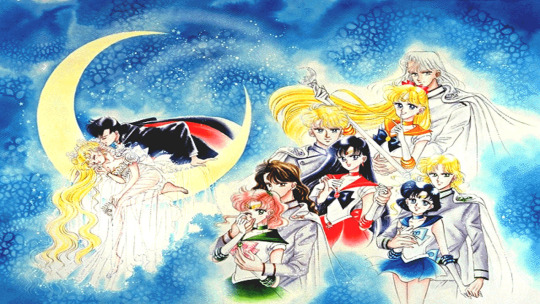
When the first Art book came out for Sailor Moon, fans were a bit surprised, or not surprised, to discover the image of Sailor Moon with Tuxedo Mask, and alongside them the Senshi with the Shitennou, as former guards of the Prince. And what’s really interesting is how she chose to set them up on the page and the way they look, particularly their body language.
So to start out with you have the main couple of Usagi and Mamoru. Now this one could be explained very easily but there’s more to the positions. Every artist finds a position that they like and nothing is done without taking into account how the image is going to look and turn out.
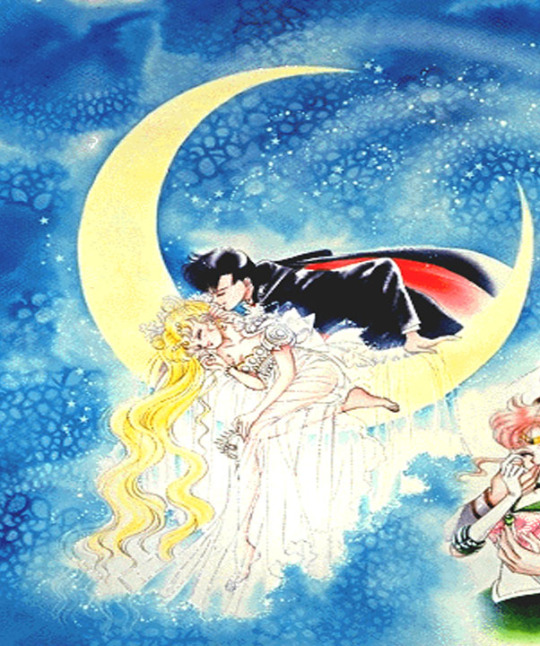
So you have Usagi (or the Princess) sleeping on the moon, curled up almost childlike in her innocence, holding a crown as Mamoru leans over, hand on the side of the moon, pushing her hair back and leaning in for a kiss.

The thing that stands out for me in this moment is the fact that she is resting like a kid in a bed, unaware of him leaning in for the kiss, indicating that she’s very innocent and pure in all this, and the kiss itself is going for her cheek rather than her lips, showing a very chaste moment. And there’s a reason for that, given that the readers of this series were mostly younger girls the idea of a more innocent love would appeal to them, and that links back to the story of Orihime and Hikoboshi and how their love was seen as far more innocent in nature.
Also her sleeping beauty like pose would imply that this is dream like in nature, and very much a fairy tale, so you have that going on there as well. I really don’t want to get into the whole history of Sleeping beauty here because there’s a LOT to dissect with that, but the over all tone of the moment is something pure that is happening between them.

We also see her holding her crown, which she never wears in the series proper, but it’s to indicate that she is seen as a royal and that at the moment she isn’t being the princess here, and it’s a moment of respite that she’s taking. Mamoru stealing a kiss is showing that he’s invested in her and that he finds her resting like this cute and wants to show her affection for it.

From the top we have Venus and Kunzite, and automatically you can see his hands are around her waist holding her close. This is typically seen as a reverse hug and is used to show affection and trust between two partners. It’s interesting that they have the most intimate, or second most intimate position in the group of guardians. Venus for her part is holding a staff, and has her finger to her lips, indicating quiet or a secret. Honestly to me it could play as her saying “Shhh, the princess is asleep” or the idea that the romances are a secret thing, which ties in with part of the Chinese version of the Tanabata myth where the marriage between the two lovers was done outside of the view of the gods.

The fact that she’s leaning into him, and he’s resting his chin, lower cheek area, on her head, shows they have a comfort with one another. He’s allowing her to lean on him for support and she feels close enough to him to let him rest his head on her, showing a warmth and affection between them that probably is very strong and understanding. And it makes sense given their roles as leaders as well as their titles. Venus being the guardian of love and beauty (as well as light) and Kunzite being the Knight of Purity (Virtue) and Affection, both having an understanding of deeper love and devotion, and loyalty.

I should note here that his hands are wrapped around her waist and interlocking showing that he has not only a protective grip on her, but one that is keeping her close to him, showing a lot more passion and ardor for her then we may see in his face. He’s enjoying having her locked up next to him, and his face shows this.
The way that they’re set up at least tells me in this case that their relationship was certainly more of a public display of attraction and affection, given that Kunzite was shown to have teased her several times in the manga and the implication there was he was attracted to what he saw in her. Clearly Venus could see both of his sides, and the idea that he was very much a noble prince like figure himself must have caught her attention.

On the other hand, you have the next one down being Mars and Jadeite, and their position. While Venus and Kunzite seem way more casual, Jadeite and Mars instead have a very regal demeanor to them. Both are smiling forward with Mars leaning back onto Jadeite’s arm, which is supporting her. Glancing to the right side of the picture his hand is cupping hers, and this is something that is kind of different in what it means in body language.
This gesture is more or less a passive hand hold, with a bit of a “my lady” gesture thrown in there. What does that mean? Well Passive hand holds usually indicate that neither one of you is clingy in the relationship, meaning that there’s a great deal of trust there and a peace between the partners that neither feels that they have to be aggressive or dominate in a traditional way. It also indicates that there’s ground rules that were set and boundaries that are in play between them. It’s also seen as a tender sweet sort of hand hold, indicating that there’s a closeness, but one that doesn’t have to be showy in nature or inappropriate affection.

Her smile is soft and delicate, not trying to be outwardly showy, while his is calm and kind and you can see it in his eyes that he’s glad to be with her at the moment and happy about it. Again, as I said in my commentary about him, Jadeite is probably the most friendly of the group, and his smile shows a warmth to his face, clear that he’s devoted to the woman that he has next to him.
And that fits right into Jadeite and Mars in that both are calm people who prefer a peaceful situation, and probably neither feels that they have to be very vocal in their feelings as both are spiritual on different levels and, given Mars role in the scouts, it’s not surprising that she wouldn’t show her feelings loudly. What’s also interesting is that that the My Lady hand hold is one of the most regale, and usually used for wedding pictures and the like. Typically it shows that a relationship is vital, firm and has equal protectiveness from both partners.

Mars hand is cupped in his in a way that shows it looking smaller, giving her a dainty like figure, but at the same time it’s in a loose fist so it shows a strength there as well, and Jadeite’s hand is curved around it, showing that he’s supporting that strength. This hand hold is seen as showing a very healthy relationship, a bond of respect, and that the romance is founded on trust and adoration. It’s interesting to note that Jadeite is supporting her on that arm as well, showing an almost half hug, and indicating that he’s got her back if she ever needs the help on something.
On the opposite hand you have what one might call a palm facing down hold. It’s an interesting way of putting their hands here and telling of a lot of things. For one thing typically it’s the guy who’s holding the girl’s hand with the palm down, but in the case, it’s Mars that has the more dominate stance here, showing that she’s protective of him, and because their hands are lightly touching this means that she’s also gentle in her actions. It also shows she’s the one that has the more dominant role in the relationship, which makes sense seeing as her powers of fire probably trump his ice powers. It also shows a bit of independence between them and that both have a strong trust in one another that they don’t always have to be joined at the hip. Given both their personalities, it’s not a surprise that Mars and Jadeite would be the least likely to outwardly show their love in large displays, but rather softer quieter moments.

From the regal to the more flirty in nature, looking down from Mars and Jadeite you see Jupiter and Nephrite. And this is a couple that probably has more moments of displays of affection then the others outright, even Kunzite and Venus. You might be wondering why I would think that, well their stance says a lot about their relationship.

To start with you have Jupiter, like Venus, leaning into Nephrite, and pressing against his chest, meaning that she feels close enough to him to want to be near him and probably they have a very warm affection towards one another. His head is tilted down into her ponytail, and normally when someone does that they’re indicating that they’re showing a nurturing and intimate gesture that shows affection and protectiveness, and a close emotional bond that indicates the person is there for the other. Jupiter for her part is winking and has his hand up to her lips kissing it. It’s all very intimate in nature and for a reason. Both characters are comforters in their own way as Jupiter is the most sensitive and understanding when it comes to emotions of others around her, and Nephrite is the Knight of Comfort.
Looking at them it’s an interesting set up here. You have Nephrite in a pose that says he’s trusting and comforting Jupiter, letting her lean on him, and knowing that he’s here to help her out. At the same time her leaning against him tells him that she cares deeply about him and enjoys being with him. She’s even winking, showing that they’re keeping something secret together and it’s almost like she’s teasing the reader in some way to learn more about their relationship.

The hands are an interesting story too. He’s brought her hand up to her heart and is holding it there. This could mean a lot of things, but the most likely is that it’s showing a sign of protection, strong bonds, and a deep attraction, indicating that they both are connected by their heart and desire to use that part of themselves to be with those that they love and care about. There is a huge amount of intimacy with that motion, and showing that there’s a lot of affection that drives these two as a couple. The fact that she trusts him enough to be that close to her body in a physical way indicates via body language that there’s a deeper connection between the two. It’s also seen as a romantic gesture.
On the other hand you have Jupiter kissing his fingers while he’s passively holding up his hand to her in an upward movement which means that to Nephrite he has a lot of trust in her and is willing to be a more passive gentle person around her, while she’s more playful. Kissing a hand shows there’s admiration, tenderness, and a desire for love. There’s also trust on the part of the giver, and a sense of respect, adoration, kindness, and in this case a playful flirty-ness that shows that the two are more likely to show displays of affection frequently and willingly.

When you look to the right of Nephrite and Jupiter you come across the couple that I think has the most interesting relationship, Mercury and Zoisite. It’s a very different stance then the other couples. Whereas Jupiter and Venus are leaning on their partners, and Mars is on Jadeite’s arm. Mercury while leaning on one side of Zoisite, is partly being hugged by him with one arm, at the same time he has his hand loosely around her wrist as she holds it up, pulling him closer to her, and on their opposite hands, which are straight out, his hand is firmly in the other in an almost princely like pose.

What stands out for me in this case, after looking up about the hand holding positions, is how actually intimate and passionate these gestures actually are for these two characters. With their faces it’s an interesting juxtaposition. Mercury doesn’t smile that brightly often, and when she does you know she’s happy about something. Whereas Zoisite hardly ever seems to smile, and the fact that his eyes show a smile to them while he’s holding her shows that he’s happy in this moment. Not to mention that she’s tipping her head towards him indicating that she feels comfortable and safe with him and trusting too boot.

Their hands are also interesting, the first pair on the left is a sort of wrist hold. Zoisite has his arm over her in a protective way, and is lightly holding her wrist. This normally indicates a passionate and more intimate relationship, one where the partners need to be around one another. It also shows an urgency and trust between them in a different way. With both being a bit distant when it comes to showing off emotions in high ways, and reliant on their smarts, is it any wonder that their bodies show more about their feelings then what they say. The way Zoisite has his hand over her shows he’s protective of her, and needs to keep her close to him.

To the right her hand is being grasped firmly in his, in a “My lady” like firm hold. Usually this indicates some possessiveness, but also a healthy one based on trust and honor, as well as respect and admiration. It also shows a desire to stay with the person, given the firmness of the grip and the fact that he has his hand over hers also indicates he’s very protective of her and is serious about his feelings towards her.
Mercury’s smile is all you need to see she’s happy and that she enjoys being with him.
I’ll end the intro here, but my plan is to go deeper into these four relationships if I can and think about how they worked and could work in the modern age.
#sailor moon#sailor moon crystal#smc#smc season 1#senshi x shitennou#shitennou x senshi#shitennou#shitennou analysis#mercury x zoisite#zoisite x mercury#ami x zoisite#zoisite x ami#sailor mercruy#zoisite#knight of purification and healing#mars x jadeite#jadeite x mars#rei x jadeite#jadeite x rei#ami mizuno#rei hino#sailor mars#jadeite#knight of patience and harmony#jupiter x nephrite#nephrite x jupiter#nephrite x makoto#makoto x nephrite#makoto kino#sailor jupiter
564 notes
·
View notes
Text
Was the Virgin Mary a mythical figure derived from the Greek goddess Athena? Um, NO, and the Prophet Isaiah will show you why:


Jesus Mythicists are a pretty tenacious lot. No matte how much proof you show them that Jesus is both a historical figure and not derived from pagan gods, they continue to hold to their beliefs with an almost religious dedication. You can show them that the so-called parallels between Christ and so called pagan saviors are almost entirely bunk, you can show them that certain historical figures fit quite well in mythical archetypes (Ivan the Terrible fits the Devil Archetype, Alexander the Great fits the warrior archetype, Magellan fits the explorer archetype, etc.), and yet still existed, and that gorillas are in the same “hairy hominid” as sasquatch and similar monsters the world over and yet still exist…and they mostly wont accept the truth. You can even show them that the sinking of the Titanic was preceded 14 years earlier by the novella “Futility/Wreck of the Titan”, whose fictional tale shares ACTUAL GOOD parallels with it…and they won’t give up their pseudohistorical fervor. Instead, they keep on making their faulty argument that Christ was a mythical figure rooted in paganism.
Just as they do with the Virgin Mary.

Jesus Mythicists will at times claim that Mary fits the mythical virgin birth archetype (a “category” that I’ll tackle in another article. BTW see the historical figures matching mythical archetypes above, notice how they fit…yet still exist). Indeed, some, if not all, will claim that the Virgin Mary was either partly or even fully derived from a particular mythical figure or deity. Some of these mythical figures are pretty odd choices, having almost nothing in common with Mary. Others are even worse.
Perhaps the oddest “candidate” is Athena.

The Greek goddess of war and wisdom, Athena is a virgin deity who was born bearing weapons and armor. Fighting in the Titanomachy (the War of the Titans), the Gigantomachy (serpent-legged giants) and in the Trojan War, Athena was considered quite a formidable deity.
But was she even more?
Was she actually…a virgin mother?
Was the Virgin Mary a mythical figure derived from her?
Let’s take a gander at this pitiful Jesus Mythicist tactic, shall we?
1. VIRGIN MARY AND ATHENA IN THE OCTAGON! AND HERE WE GO!

First, are there any parallels between the Virgin Mary and the goddess Athena?
Answer: only a few, and not very good ones:
1. Both had unusual births (Athena was born out of Zeus’ forehead, while Mary, according to Catholic dogma, was born without a sinful nature; she didn’t inherit the sinful nature of Adam at conception (The Immaculate Conception. BTW this is not taught in the Bible; its a tradition that was devised after the New Testament was written).
2. Both are female (eye roll moment).
3. Both from the Mediterranean region (Mary lived in Israel, Athena on Mount Olympus. Both Greece and Israel connected with the Mediterranean Sea).
4. Both were from the ancient world.
5. Both depicted as white in art (though Mary not only wasn’t originally white, but she’s also been depicted as Asian, Black, Native American, etc.
6. Both were prayed to.
7. Both miracle workers (though the Biblical Mary didn’t perform miracles, extra-biblical tradition held that she had miraculous powers in the hereafter, and miracles involving the spirit of Mary have been reported).
8. If the Jesus Mythicists are correct, both are virgin mothers (more on this later).
9. Athena is a lifelong dedicated virgin: in Catholicism, Mary is a perpetual virgin (this idea arose in the second century, decades after the New Testament was written. Its not found in the Bible).
10. Both depicted as warriors bearing weapons (Mary is sometimes depicted as bearing weaponry in art, but not most of the time. She’s not depicted as bearing weapons in the New Testament).


11. Both embodiments of wisdom (Catholics link Mary to the feminine personifications of Holy Wisdom (called “Sophia”) found in both Old Testament (Proverbs 8) and the Old Testament apocrypha (Sirach 1:9). Mary was not linked to such in the New Testament, the idea arises after the New Testament was written. Athena is the goddess of wisdom as well as war).
12. Both said to have defended cities from invading armies, driving the invaders away (once again, Mary is not said to have done this in the New Testament: these supposed military actions of Mary occurred long after the New Testament was written).
13. If Jesus Mythicists are correct, both their son’s virgin births were unusual in other ways (More on Athena’s son later. Jesus birth was heralded by an angelic proclamation, which led the shepherds to find the holy family. In some extra-biblical literature, Mary is depicted as giving birth to Christ without feeling Labor Pain, or "giving birth” by means of supernatural teleportation (i.e. Jesus being seemingly teleported out of her womb. In one account, this teleportation was accompanied by a great light. This teleportation is to explain the extra-biblical belief that Mary’s hymen was intact despite giving birth to Jesus. Keep in mind that these extrabiblical tales, by definition, are not in the Bible (and even contradict it).
14. Athena is immortal. According to Catholic dogma, after she died, Mary’s body was taken up to heaven and reunited with her soul, thus resurrecting in a new immortal body (The Assumption of Mary. Once again, this doctrine is not taught in the New Testament: it arose after the Bible was written).
15. Both are mediators (In Sophocles’ ancient play “Ajax”, Athena is mediator between her fellow gods and humans. In Catholic dogma, Mary is the mediator between Jesus and Christians).
Repeat: 15 parallels (one source claims that there are countless others...without providing evidence. More on this later). Sounds impressive...yet many of these “parallels” are so broad as to be downright hilarious. Both female, for crying out loud? Both from the Mediterranean region (how many gods and heroes, including heroes of faith, were known from that region? Countless!)? Both from the ancient world (ancient world was of course loaded with such)? Both Miracle workers (many gods and human miracle workers were noted in the ancient world, big deal. Plus, in the Bible, Mary isn’t a miracle worker). Both depicted as white in art? So are most biblical and all figures of Greek, Roman, Norse and Celtic mythology. Both prayed to? Though Mary is prayed to by Catholics, they don’t see her as a goddess, let alone pray to her as if she is one. Athena, on the other hand, was a pagan deity whom ancient Greeks prayed to as a goddess.
However, the virgin motherhood, perpetual virginity, military imagery, defending cities, being embodiments of wisdom, their mediative duties, their unusual births, the unusual births of their sons and immortality are striking, to say the least. However, you’ll notice that out of all of these parallels, all but two originate long after the New Testament was written. The Bible doesn’t indicate that Mary fought in battles and bore weapons, saved cities, was extremely wise or stayed a virgin her whole life. Indeed, she had other children ( Matthew 12:46-50, 13:55-56; Mark 3:31, 6:3; Luke 8:19; John 2:12, 7:3; Acts 1:14; 1 Cor. 9:5, Galatians 1:19), which debunks the dogma of perpetual virginity. The birth of Jesus was far out, but not as far out as later extra-biblical texts indicate (and any birth of a deity, or one involving a deity, would be highly unusual anyway, big deal. Course, that parallel rests on the assertion that Athena was a mother. Was she? Keep reading...). Yes, the Bible teaches that, in the future, Christians, both dead and alive, will be caught up in a rapture, attaining immortal bodies (1 Cor 15:50-55)...but nowhere in the Bible does it state that Mary underwent this; her transformation, like ours, is likewise future. And when it comes to Mary being a mediator/intercessor: though some Catholics cite the story of the wedding feast at Cana (John 2:1-12) as prooftext for this doctrine...Mary isn’t praying to Jesus at the feast: she’s simply talking to him. True, its implied in the biblical story that Mary wants Jesus to perform a miracle (in this case, miraculously make more wine), but nevertheless, this isn’t a prayer, only an implied request, talking in the manner that most people do when conversing with each other. Otherwise, we’d have to conclude that everyone who spoke to Jesus in the New Testament, including Caiaphas the High Priest (who successfully plotted Jesus’ death) and Pontius Pilate (a pagan), prayed to Jesus as well! To say that this passage indicates that Mary is an intercessor between Christ and man is an unbelievable stretch.

The truth is, this doctrine also postdates the New Testament (seeing a pattern?).
Not very good parallels. Now, to be fair, you might be able to force some more “parallels”, but they’d be just as strained (just like most of the “parallels” between Jesus and certain pagan “Christs”). The only way some of the above parallels start to connect is if we compare Athena to Mary as she was later viewed in Catholic dogma, not as she is depicted in the Bible.
And this is a vital clue as to what might be going on here.
While parallels, in and of themselves, mean nothing (as I’ve shown in other articles that debunk Jesus Mythicist claims), when you combine them with the fact that several temples to Athena were built on lands that later held churches honoring Mary (with at least one such church built over the site of a temple to Athena), and the long history of religious syncretism in both the ancient world and the church (Paul identified the Unknown God of Athens with Yahweh in Acts 17:23) one could easily conclude that, instead of Athena being the origin of the Virgin Mary, her myth influenced how Christians viewed the Virgin Mary. One can easily imagine that the early church, faced with popularity of Athena aka Minerva, might have started to depict Mary as a “new” Athena, a new (yet not divine) religious female role model, in order to lure pagans from Athena (Just as pagans most likely added aspects of Mary to Hera and tried to lure Christians away from Christ as a result). After all, the oldest depictions of Jesus (i.e. the oldest made by Christians themselves, which depict Jesus as having shorter hair and being clean shaven) heavily borrow from depictions of pagan deities and heroes (Apollo, Hermes, Orpheus, etc). Indeed, the later depiction of Jesus as having long hair, beard and mustache was derived from the way pagan Romans depicted most of their top male deities, such as Jupiter. In this regard, we could see aspects of Athena, including her perpetual virginity, passing on to Mary as a result.
There is also the fact that some of these dogmas about Mary were originally found...in ancient Gnostic texts. Though the early church abhorred gnostic teachings, the Gnostics nevertheless seem to have had an influence on it.

However, when it comes to comparing Athena to the biblical Mary, the only parallel that’s interesting, if true, is the idea that they are both Virgin mothers. If this is the case, it would be fascinating…but still wouldn’t help the Jesus Mythicist case (Just 1 good parallel? Big whoop!).
Nevertheless, before we engage with Athena’s myth, let’s go over the ways that Mary (as depicted in the Bible) and Athena actually differ:
1. Mary is from a monotheistic background: Athena is from a Polytheistic background.
2. Mary is Jewish. Athena is a goddess of the Greeks.
3. Mary is human, Athena is a deity.
4. Mary was mortal, Athena immortal.
5. Mary, like any other human, was born like every other baby: naked and an infant. Athena was born as a full-fledged adult, bearing armor and weapons.
6. Despite both being rendered as white, they are otherwise depicted quite differently in art.
7. Athena never married and had sex: Though originally a virgin, Mary had sex with her husband Joseph after Jesus was born, having several more sons and daughters as a result (Matthew 1:24-25, 12:46-50. Remember, the idea that Mary was a perpetual virgin is extrabiblical tradition that post-dates the New Testament by decades).
8. Mary wasn’t a warrior, let alone a veteran. Athena was.
9. Mary didn’t seek worshippers. Athena did.
10. Mary didn’t compete with Poseidon to win the worship of Athens. Athena did.
11. There is not indication that Mary’s father ate her mother. Zeus swallowed Metis, Athena’s mother, whole.
12. Mary, like any other human, was born of a woman in the normal way: Athena was born out of Zeus’ forehead (Zeus ate Metis while she was pregnant with Athena. She eventually emerged from Zeus’ forehead. Once again, the dogma of the Immaculate Conception didn’t arise till some time after the New Testament was written. Its not biblical).
13. Mary aged. Athena does not.
14. Both wear different clothing.
15. Mary is never depicted in the Bible as having weapons. Athena has a spear and shield.
16. Ancient Greek religion, of which Athena was a major part of, eventually passed into history: Christianity, of which Mary is amongst its greatest heroes of faith, thrives today.
Need I really go on?

Even if Athena turns out to be a virgin mother (I promise, more on that later), it still wouldn’t change the fact that she’s about a similar to the biblical Mary…as Marvin the Martian is similar to Alexis Bledel!!!!!!!!


Well, come to think of it, both Alexis Bledel and Marvin the Martian speak English, both originated in America (Looney Tunes, of which Marvin the Martian was on, was made by Warner Brothers, an American company. The late Chuck Jones, who invented Marvin the Martian and several other Looney Tunes characters, was an American. Alexis Bledel was born in America), both have been on TV, both have elicited laughter (the former on “Gilmore Girls”, the latter on Looney Tunes), both have fans, both are connected to warner Brothers (Both Looney Tunes and “Gilmore Girls” (the latter Starring Alexis Bledel) were produced by Warner Brothers), both are soft spoken, both wear skirts, and last but not least (eye roll) their first names each consist of six letters!

Maybe there’s a connection…LOL!

See how stupid that flow of logic is?
And yet, Jesus Mythicists will go down that illogical road when it comes to Mary (as well as Christ).
Now, some Jesus Mythicists will change tactics, trying to argue that the myth of the virgin birth of Athena’s “offspring” (more on him later) simply inspired the biblical tale of Christ’s virgin birth, without going so far as to say that Mary herself was derived from Athena. They do this in order to sneak around the obvious mountains of differences between Athena and Mary.
But…was Athena really a virgin mother?
Prepare to be shocked.
In some versions of her myth…she actually was a virgin mother!
Technically…
2. LAW & ORDER: DVU (DIVINE VICTIMS UNIT).

According to Greek myth, Hephaestus, the Greek god of forges and fire, had the hots for Athena (no pun intended). Athena, however…didn’t have the hots for him. Even if she had, she was a dedicated virgin. Hephaestus still wanted to get it on with Athena, though, and eventually tried to do so. Athena fled, but eventually Hephaestus caught up with her. Driven by a bestial lust, he attempted to rape the goddess.
Can you say “bad move”?
Athena is a goddess of war and wisdom.
Repeat: WAR and wisdom!
Guess how it turned out for little old Hephaestus?
She kicked his butt, and he never got to have sex with her.
However, some of his sperm fell onto her leg.
EEEEEWWWWWWWWWWWW!!!!!!!

Grossed out, Athena took some wool, dried the semen off, and threw it away. It landed on the ground, where…it eventually turned…into a baby named Erichthonius. In some depictions, he looked like a normal infant, but in others, he was half snake, half man. Athena made sure that he was well cared for, and eventually, he went on to become the King of Athens, which just happened to be named after Athena (she was also its patron goddess, due to winning a contest where she competed against Poseidon for the worship of its people).
Now…this myth doesn’t state that Athena had sex, let alone got pregnant. Indeed, she merely wiped semen off her leg and threw it away. If a woman wiped some guy’s semen off her leg with a rag, threw the rag on the ground and saw a half human, half snake erupts from it…she wouldn’t think of herself as its mother; she’d probably either run to her vehicle and try to drive off-all the while hoping that its engine won’t fail to start like you see in many horror flicks-or get any available weapon and try to kill it!

Nevertheless, Athena was a goddess, and it doesn’t take much to imagine from her myth that, when the semen got on her leg, some of her divine essence went into it. Thus, she became Erichthonius’ “mother”. However, Greek mythology is often far from consistent: not only does Erichthonius’ myths get swapped at times with those of a mortal named Erechtheus (as happens in Homer’s Iliad), and not only does Athena, in one version of this myth, simply vanish instead of fighting Hephaestus off, thus avoiding being touched by his semen, but while some ancient Greek sources indicate that Athena is Erichthonius’ mother, others indicate that Gaia, the primordial Greek earth goddess was his mother. Its not hard to understand the latter idea: after all, Gaia was not just merely an earth goddess, but the personification of the earth, and Hephaestus’ semen fell on the earth. However, one could reconcile these myths, to where both Athena and Gaia are Erichthonius’ mothers. After all, Theseus, the slayer of the Minotaur, had one mother and two fathers, one of the latter being Poseidon. Why couldn’t the ancients think the same thing about Erichthonius? Why couldn’t he have two mothers and a father? Along with this, considering that Gaia was the earth personified, and in the myth, Hephaestus’ semen hits the earth, where Erichthonius springs up from, it was a given in the myth that Gaia was also is mother. Thus, this Greek myth should always be understood as indicating that Erichthonius had two mothers, Gaia and Athena (keep in mind, while Athena never had sex, Gaia did). However, there is another version of the myth where Hephaestus sires Erichthonius by Atthis, a mortal woman. There is no hint of a sexless conception in this version of the myth.
Interesting differences for sure.
The differences build up when you look at the Roman version of this myth.

Vulcan, the Roman equivalent of Hephaestus, had built thrones for the gods, ones made out of Adamant and gold. While most of these were simply spiffy throne’s, Juno, the Roman equivalent of Hera, discovered that hers was a trap: the moment she sat in it, she found herself both levitating and incapable of getting off the throne. Vulcan refused to get her out at first (if Hera/Juno threw you off Olympus, you might be a tad angry at her too), but after he was allowed to move back to Olympus, and after Liber aka Bacchus, the Roman equivalent of Dionysus, got him seriously drunk, he relented. Zeus wanted to give him a reward.
What did Vulcan ask for?
The hand of Minerva, the Roman equivalent of Athena, in marriage.
Vulcan thought he had it made, thought that he was about to savor Minerva. Minerva, however, had other ideas, and when he tried to make love to her, she fought him off. During this clash, Vulcan’s semen fell to the earth, which gave rise to Erichthonius.
In this version of the myth, Vulcan’s semen didn’t touch Minerva, and thus nothing of her passed on to it. She’s therefore isn’t his biological mother in any way shape or fashion (though she still treated him like a son). Considering that the earth once again gives birth to Erichthonius, one can easily conclude that therefore Tallus or Terra, the Roman equivalent of Gaia, is his mother. However, Ovid, the ancient Roman poet, stated that Erichthonius had no mother, while Cicero, the ancient Roman writer, states that Minerva was indeed his mother (which hints that there was another Roman version of the myth where Vulcan’s semen touched her). Along with this, according to “The Life of Apollonius of Tyana “ (which, contrary to some sources, was written some time in the 2nd or 3rd centuries AD, not the 1rst century (Philostratus was born in the late 2nd century), not only did Domitian, a Roman emperor who reigned in the late 1rst century AD, claim to be the son of Athena (his real mother was Flavia Domitilla Major, a normal human woman), but that Athena, though a virgin, “bore a Drakon [Erikhthonios] to the Athenians.” (see Life of Apollonius 7. 24). However, none of these rules out the possibility that at least some Romans would have considered Tallus to be either his mother or one of his mothers (When “Life of Apollonius of Tyana” states that Athena “bore” Erichthonius, it could simply be indicating that she was one of his mothers, without necessarily indicating that she gave birth to him. Indeed, as already mentioned, In Philostratus’ book, Domitian claimed to be the son of Athena, even though a mortal woman gave birth to him, and Apollonius is comparing Domitian’s claim to be Athena’s son to Erichthonius being Athena’s son. This comparison is far more apt when the full myth, including Erichthonius being conceived by Athena and born by Gaia the Earth, is taken into consideration. Plus, keep in mind that “Life of Apollonius” though somewhat a biography of the 1rst century miracle worker Apollonius, is filled with anachronisms and other errors. Also, scholars conclude that its likely that Philostratus borrowed from Christianity in order to enrichen his work on Apollonius (the New Testament was written in the 1rst century AD). If Philostratus was actually intending to mean that the virgin goddess Athena was both pregnant with and gave birth to Erichthonius, then its likely that he borrowed this idea from the Gospel accounts of the Virgin Mary giving birth to Christ. Keep in mind, there is no ancient text, let alone one that predates Christianity, that indicates that Athena became pregnant and gave birth). Indeed, aside from Ovid’s take on the myth, it should otherwise be a given that Tallus/Terra is his mother, due to the fact that, like Gaia, she is the earth personified. Vulcan’s seed fell on Tallus aka the earth, and from that union of divine seed and soil, Erichthonius sprang. Thus, Tallus/Terra, both goddess and earth personified, gave birth to him.
Like many Greco-Roman myths, this one has several versions, yet in most, it seems that Athena/Minerva displays maternal instinct to Erichthonius, even raising him in some versions of the myth. Thus, in some of these, she is a virgin stepmother. However, there is not getting around the fact that, in some versions of the myth of Erichthonius, Athena/Minerva is one of his mothers.
Now, considering that this myth predates the New Testament by at least centuries, should we therefore conclude that the story of Christ’s virgin birth was derived from that of Erichthonius’ virgin birth?
Um…NO.

For one, in most versions of this myth, its obvious that Gaia, the Roman Tallus, is also Erichthonius’ mother. Not only that, but Gaia is the one who gave birth to him. Keep in mind, Gaia/Tallus both had sex and gave birth to multiple offspring long before this event. Though Athena and Hephaestus did “conceive” him, Gaia was “pregnant” with him and delivered him. Thus, while we can say that he was virgin conceived, he wasn’t virgin born. Even if the earth is simply just referring to the planet without any divine personification (as Ovid oddly seems to do), we can’t really call it a virgin birth then (virgin is never defined as an object that’s never had sex. Check dictionaries). Its as eat-up-with-the-dumb as calling Mithras “virgin born” because he was born out of a rock!
Keep this in mind, as we continue...
Also, Christianity was originally a Jewish sect. The earliest Christians didn’t see their movement as a new religion, but simply a branch of Judaism. Jesus himself was a Jewish rabbi. Now, given all of this, we need to ask a serious question: why are people trying to claim that the Christian story of the Virgin birth was derived from Paganism…while Ignoring the Virgin birth prophecy (repeat: prophecy) of Isaiah chapter 7?
The Prophet Isaiah wrote the biblical book that bears his name in the 8th century BC. Isaiah himself gives the time frame when he wrote from the time of Uzziah to Hezekiah, which occurred during that time. Although many scholars believe that chapters 40-66 were written by later authors, even if there were no good reasons to object to their belief (and as it so happens, there are), that still means that Isaiah 1-39 were the works of Isaiah the Prophet, and thus date back to the 8th century BC.
Repeat: 8th century BC!
Why is this important?
Because the prophecy of the virgin birth occurs in Isaiah…chapter…7!
Let’s take a look at Isaiah 7:10-14, shall we?
“Again the Lord spoke to Ahaz: “Ask a sign of the Lord your God; let it be deep as Sheol or high as heaven.” But Ahaz said, “I will not ask, and I will not put the Lord to the test.” And he said, “Hear then, O house of David! Is it too little for you to weary men, that you weary my God also? Therefore the Lord himself will give you a sign. Behold, the virgin shall conceive and bear a son, and shall call his name Immanuel.” (Emphasis mine).
Now, some may object, saying that “Almah”, the Hebrew word translated as virgin in the passage, doesn’t mean virgin, but a young maiden. Indeed, some will argue that “betulah” would have been used if Isaiah was intended to refer to a virgin here. However, though Almah doesn’t normally refer to virgin, it CAN refer virgins (the same actually goes for Betulah as well).
Don’t take my word for it.
Take King Solomon’s.

He calls some virgins “alamot” (plural for Almah) in the following, where he is praising his great love:
“You are beautiful as Tirzah, my love,
lovely as Jerusalem,
awesome as an army with banners.
Turn away your eyes from me,
for they overwhelm me—
Your hair is like a flock of goats
leaping down the slopes of Gilead.
Your teeth are like a flock of ewes
that have come up from the washing;
all of them bear twins;
not one among them has lost its young.
Your cheeks are like halves of a pomegranate
behind your veil.
There are sixty queens and eighty concubines,
and virgins without number.” (emphasis mine).
Song of Solomon 6:4-8.
“Alamot” is translated in Song of Solomon 6:8 as “virgins” in some modern bibles, including the ESV and NIV (though its translated as “maidens” or “young women” in others). Specifically, these “alamot” are contrasted with both “queens” and concubines in this passage. If you look closely, you’ll see that these alamot are specifically palace virgins. This refers to the three-tiered harem system of the ancient near east. The “queens” were the top members of the harem, the most favored. Indeed, their sons could potentially succeed the King after he dies. Concubines come second, their sons unable to claim an inheritance unless their kingly father allows it. At the bottom were the maidens, girls who either simply hadn’t given birth yet…or to actual virgins, who hadn’t yet slept with the king. In some harems, the third tier was structured differently, with the lowest tier being composed only of virgins, the second concubines and the top tier “queens”, as seen in Esther chapter 2.
Now, some may object, noting that the maidens of the third tier included those who had sex and yet hadn’t had offspring yet, and thus, the “almahs” of Solomon 6:8 are not virgins. However, the third tier need not be mutually exclusive: it can include both those who hadn’t born the king children yet, and to virgins. Thus, its still indicative that “Almah” can in some cases refer to virgins. Others will object, saying that in the next version, Solomon refers to his love, the object of his desire in Song of Solomon, as “My dove, my perfect one, is the only one, the only one of her mother, pure to her who bore her.” Thus, she is “pure” as opposed to those “virgins” in the next chapter and thus, “virgins” isn’t a good translation of “Almah” in that passage. However, if virginity was being referred to in verse 9, why is it that it doesn’t state that she is “pure to her beloved” or simply “pure”, instead of “pure to her mother”? Plus, some modern bible translations don’t even use the word “pure”. Indeed, some indicate that she is the favorite or perfect child of her mother. Indeed, some even indicate that she is the only daughter that her mother has. Thus, “pure” could simply be the way her mother sees her. Indeed, the passage, as translated in the ESV and several other modern translations, note that Solomon’s love is pure to her mother, not pure to anyone else. The wording should not be seen as indicative that, out of all the women mentioned in Song of Solomon chapter 6, that only Solomon’s love is a virgin. Plus, where is the evidence that the Israelites never, ever had virgins in their royal harems? Thus, the fact that Solomon 6:8 uses Alamot, the plural of Almah, to refer to virgins is still sound.
Along with this, “Almah” is used of Rebekah, Isaac’s future wife, in Genesis 24:43 (translated as “maiden” here in the NIV and “virgin” here in the ESV).
Why is this important?
Because she’s stated to be a “maiden whom no man had known” in verse 16 of the same chapter!

Indeed, “Betulah” is used of her in verse 16 as well (translated as “virgin” in the NIV and “maiden” in the ESV. Once again, keep in mind that Betulah doesn’t mean virgin unless the context is indicative of such, something that objectors forget)!
Along with this, Almah specifically denotes a girl who’s coming into puberty. It’s a known fact that girls don’t start having periods when they first enter puberty. Indeed, it can be on average two years before that happens. girls cannot get pregnant until about 2 weeks before they have their first periods. In ancient Jewish culture, girls could be betrothed at a young age, and yet wedding plans weren’t kicked into high gear…until the girl had her first period. Though this was most likely to occur at about 13-14 years old, considering that the legal age of marriage for girls at the time was 12, sometimes a girls’ entrance into puberty, and her subsequent first period, occurred a bit earlier.
Almahs were expected to be virgins in ancient Israel.
Thus, we can conclude that the passage is indeed indicating a virgin birth.
Let’s keep in mind, Isaiah 7:14 (the very passage that mentions a future virgin birth) is quoted in Matthew 1:23.
What came before Matthew 1:23?
The discovery of Mary’s virgin conception (Matthew 1:18-21).
Now, which is more similar to the story of the virgin birth of Christ: a prophecy foretelling that a virgin would both conceive and give birth to a son...or a myth were Hephaestus’ seed fell on Athena’s lap, she wipes it off with wool and drops both to the earth, i.e. Gaia (who is no virgin), where she gives birth to a half human, half serpent?
See what happens when you actually consider Christianity’s Jewish context?
Folks, the story of Christ’s virgin birth wasn’t inspired or borrowed from Athena’s myth.
It’s a real-life fulfillment of Old Testament prophecy.

Sources:
https://www.thecollector.com/virgin-mary-athena/
https://cac.org/daily-meditations/sophia-wisdom-of-god-2017-11-07/#:~:text=In%20these%2C%20%E2%80%9Cthe%20wisdom%20of,8%3A22%2D31).
https://www.britannica.com/topic/Immaculate-Conception-Roman-Catholicism
https://www.britannica.com/topic/Assumption-Christianity
https://www.youtube.com/watch?v=u6pucfGK444&t=15s
https://www.youtube.com/watch?v=q41551NTPCA&t=43s
https://www.tumblr.com/sirtravisjacksonoftexas/684245619073826816/was-the-virgin-mary-a-mythical-figure-derived-from
https://talesoftimesforgotten.com/2020/03/29/what-did-jesus-really-look-like/
https://www.youtube.com/watch?v=7DUekrCnye8
https://www.google.com/books/edition/Greek_Gods_Goddesses_4_In_1/V9G4EAAAQBAJ?hl=en&gbpv=1&dq=Athena%2BGoddess%2BMediator&pg=PT361&printsec=frontcover
https://classics.mit.edu/Sophocles/ajax.html
https://sites.psu.edu/leadership/2014/09/13/jungian-archetypes-and-historical-leaders/#:~:text=There%20are%20of%20course%2C%20too,Devil%20(Wedgeworth%2C%202009).
https://apologeticspress.org/does-mary-intercede-for-christians-2676/
“Homer: The Iliad”, Translated by Robert Fagles, 117, 503-519 (especially 510), 533-34,
“Apollodorus’ Library and Hyginus’ Fabulae: Two Handbooks of Greek Mythology” Translated, with Introductions, by R. Scott Smith and Stephanie M. Trzaskoma, 68, 152-53
“Titans & Olympians: Greek and Roman Myth” by Tony Allan, Sarah Maitland and Dr. Michael Trapp (consultant), 70-72
“The Penguin Dictionary of Classical Mythology” by Pierre Grimal, 66-67, 128, 139-40, 180-81,
“The Ultimate Encyclopedia of Mythology” by Arthur Cotterell and Rachel Storm, 27, 39, 48-49, 64
“Clash of the Gods” Minotaur episode.
“IVP Bible Background Commentary: Old Testament” by John H. Walton, Victor H. Matthews and Mark Chavalas, 579
“The Jesus Legend: A Case for the Historical Reliability of the Synoptic Jesus Tradition” by Paul Rhodes Eddy and Gregory A. Boyd, 151-54
“The Portable Seminary: A Master’s Level Overview In One Volume” by David Horton (General editor), 281
“Zondervan NIV Exhaustive Concordance, 2nd Edition” by Edward w. Goodrick and John R. Kohlenberger III, 718, 1210, 1382, 1466
“Archeological Study Bible (NIV), 1051, 1055
“Can Archeology Prove The New Testament” by Ralph O. Muncaster, 32
“The Roman Catholic Controversy” by James White, 211-4
“The Fast Facts on Roman Catholicism” by John Ankerberg and John Weldon, 49-54
“The West: Encounter And Transformations (Concise Edition)”, by Brian Levack, Edward Muir, Michael Maas and Meredith Veldman, 111
“Historical Atlas: A Comprehensive History Of The World”, by Dr. Geoffery Wawro (chief consultant), 84
“In the Footsteps of Jesus” (A National Geographic Book) by Jean-Pierre Isbouts, 86-87, 90, 115
“Nelson’s Illustrated Encyclopedia of the Bible” edited by John Drane, 96
“Answering Jewish Objections to Jesus, Volume Three: Messianic Prophecy Objections” by Michael L. Brown, 17-31
“Miracles of Mary: Apparitions, Legends, and Miraculous Works of the Blessed Virgin Mary” by Michael S. Durham.
https://udayton.edu/imri/mary/m/marian-prayer-reasons-why.php#:~:text=Catholics%20do%20not%20pray%20to,half%20of%20the%20Hail%20Mary).
https://www.google.com/books/edition/Encyclopedia_of_Greek_and_Roman_Mytholog/tOgWfjNIxoMC?hl=en&gbpv=1&dq=Erichthonius%2BAthena%2BGaia&pg=PT170&printsec=frontcover
https://www.google.com/books/edition/Encyclopedia_of_Greek_and_Roman_Mytholog/tOgWfjNIxoMC?hl=en&gbpv=1&dq=Erichtonius%2BAthena&pg=PT103&printsec=frontcover
https://homer.chs.harvard.edu/read/urn:cts:greekLit:tlg0525.tlg001.perseus-eng2:1.18.2-1.22.2
https://www.britannica.com/topic/Erechtheus-Greek-mythology
https://www.theoi.com/Text/Pausanias1A.html
https://www.theoi.com/Text/VirgilGeorgics2.html
https://www.theoi.com/Olympios/AthenaMyths.html
https://www.perseus.tufts.edu/hopper/text?doc=Eur.%20Ion%201002&lang=original
https://www.poetryintranslation.com/PITBR/Latin/VirgilGeorgicsIII.php#anchor_Toc534252740
https://www.greekmythology.com/Myths/Mortals/Erichthonius/erichthonius.html
https://www.greekmythology.com/Myths/Mortals/Erechtheus/erechtheus.html
https://www.google.com/books/edition/DK_Eyewitness_Top_10_Athens/FfanDgAAQBAJ?hl=en&gbpv=1&dq=Erichtonius%2BAthena&pg=PT127&printsec=frontcover
https://www.google.com/books/edition/A_Companion_to_Greek_Religion/yOQtHNJJU9UC?hl=en&gbpv=1&dq=Erichtonius%2BAthena&pg=PA227&printsec=frontcover
https://www.google.com/books/edition/Heroes_and_Heroines_of_Greece_and_Rome_R/CB1fEAAAQBAJ?hl=en&gbpv=1&dq=Erichtonius%2BAthena&pg=PA99&printsec=frontcover
https://www.worldhistory.org/athena/
https://www.worldhistory.org/Cicero/
https://www.youtube.com/watch?v=eI15ExvNzvM&list=LL&index=25&t=1s
https://www.youtube.com/watch?v=puLgX-zp0_c&list=LL&index=27
https://biblehub.com/parallel/songs/6-8.htm
https://biblehub.com/parallel/songs/6-9.htm
https://www.britannica.com/topic/Warner-Brothers
https://www.britannica.com/topic/Looney-Tunes
https://screenrant.com/looney-tunes-funniest-ways-marvin-martian-tried-blow-up-earth/
https://looneytunes.fandom.com/wiki/Marvin_the_Martian
https://looneytunes.fandom.com/wiki/Chuck_Jones
https://www.imdb.com/name/nm0088127/
https://sirtravisjacksonoftexas.tumblr.com/post/628113211750776832/do-supposed-parallels-between-the-gospels-and
https://sirtravisjacksonoftexas.tumblr.com/post/628111397046370304/is-jesus-one-of-the-dying-and-rising-gods-and
https://www.google.com/books/edition/Horace_s_Odes_and_Carmen_Saeculare/NIwvEAAAQBAJ?hl=en&gbpv=1&dq=Terra+earth+personified&pg=PA427&printsec=frontcover
https://www.livius.org/sources/content/philostratus-life-of-apollonius/
https://www.britannica.com/biography/Flavius-Philostratus
https://www.worldhistory.org/domitian/
https://sirtravisjacksonoftexas.tumblr.com/post/627545088930775040/was-jesus-a-copy-of-the-pagan
https://dictionary.cambridge.org/us/dictionary/english/virgin
https://www.merriam-webster.com/dictionary/virgin
https://www.tumblr.com/sirtravisjacksonoftexas/736744949691908096/marvin-the-martian-and-alexis-bledel-the?source=share
1 note
·
View note
Text
Dealing with the expanse

I am obsessed with open circles, circles that aren’t quite. Locks of hair. Unlocked bikes, phones, openings. They scare me, and anger me. The discomfort is refreshing. It feels like movement. How does the finished product form when just a moment ago it was the unfinished product? What if it is possible to never finish anything?
What if I ride this wave out forever?
A nice rule for myself for living: Seek discomfort. Everything I love is uncomfortable, because it is unconquerable. It stretches until it can’t be seen. Everything that brings me joy is littered with spikes. The important thing is to forget about sitting down. Invite the unknown, the
Ahoy; I am here to stay! I announce it.
In french to stay is rester. The french have a phrase for words that sound like what they are not: Faux Amis. Rester is the perfect example.
to stay: to travel, to stay: to fight. To stay: to agonise, to stay: to edit.
Staying welcomes the Aha! Moment. During your stay, you go to sleep.
Artist Tal R says about the life of a painter: You try hard, you wake up the next morning, you try again
So I am dealing with the expanse. It is a snowy day, but almost no snow is visible. There are only gaps of footprints which can be caved.
Be creative, There is still snow on the backs of the leaves. There is new snow in your hair.
Why are we looking for snow? Somebody asks. The room goes silent. Somebody breathes in one of the gaps. The absence of feet has become interesting. Who walks here?
C is my new favourite letter. O is what could have been. C is on it’s way to becoming O, which must be prevented at all costs.
There is a revolution happening in my living room, where I open the table at which I am sat.
After considerations of open forms and openings on a page, I explored this physically and through writing... the text above and the image of my dismantled or conceptually ‘opened’ living room table are both titled ‘dealing with the expanse’ - They deal with my initial desires to explore ‘openness’ as a rendition of discomfort, but also of possibility to myself - somebody drawn to closed shapes and controlled environments and clear cut concepts.
They are also partly based around seeing Art History as a broad expanse that I seek to explore and infiltrate, but that I also feel shy of, as such an endless field of knowledge and art... the text asks, in some ways, where to begin journeying through this environment.
One thing that made me start thinking of Art History in this way is the single page of a book that I once purchased at a garage sale- without any knowledge of the book from which it is derived. The title of the work it discusses: ‘The Table’, by Georges Braque, made me think about how each work in art history is similar to an item of furniture, such as a table, that could exist in many different ways and be pulled apart and investigated endlessly. Of course, this very literally was an inspiration for the taking apart of my living room table...
These works become, I think, a celebration of the endless nature of art history, or ways of looking at or making art, though I can shy away from this.
0 notes
Text
How To Master Your Thinking Around Money.
Have you ever made a New Year’s resolution to start saving for your pension, only to find that by the next year you haven’t managed to save a penny? Are you frustrated and bewildered by your own erratic shopping habits?
We all like to think that we’re rational creatures who make cool, informed decisions about everything in our lives. But when it comes to money, that simply isn’t true. As a small kid, we’re already becoming “financially socialized” by our parents, soaking up information about what money means and how to behave with it. By the time we grow up, money has become layered with our own complex associations and emotions. We link it to comfort, freedom, and security. It can make us feel exuberant, or filled with shame. No wonder we can’t make rational decisions – money pushes all our buttons!
In this post, you’ll have a chance to explore your own irrational thinking about money and become empowered to make better decisions about how you spend it, and what you spend it on.
Money evokes strong feelings in all of us.
Imagine seeing a million dollars going up in flames in a bonfire, the enormous pile of crisp 50-dollar notes emitting belches of foul smoke as it burns away. How would you feel? Probably nothing short of unbridled horror and fury, right?
Well, that’s precisely what British art duo the K Foundation did in 1994: they lit one million pounds on fire. The motivation behind their action? To perform a conceptual art piece.
You’re probably asking why on earth two men would burn such a vast sum of money – money that could have been used to buy food for the hungry or houses for the homeless. How could they have been so selfish?
According to one of the art duo’s members, Bill Drummond, they hadn’t actually destroyed anything real. They’d burned a big pile of paper rather than, say, apples and bread.
And therein lies the inherent contradiction of money. In a way, Drummond is right. Paper money in itself is valueless – or at least it would be if you lived on a desert island where there was nothing to buy.
But we don’t live on such an island. In reality, a million pounds can be exchanged for an enormous range of things. You could buy truckloads of apples or even create a huge apple orchard that could feed schoolchildren for generations to come.
If the K Foundation had destroyed a yacht, or a diamond ring valued at a million pounds, they may have received less of a backlash. But instead they destroyed something that was essentially a blank check for everybody’s dreams and aspirations. Understandably, this led to them facing a huge amount of controversy.
The backlash the art duo received derives from a simple truth: we all imbue money with meaning. We imagine what we could do with it, or how it could make our lives easier, happier, and more powerful. We resent others who have more of it. And we mourn the times we’ve lost it.
Money affects our lives so much that many yearn to enter a currency-free utopia. Imagine a world where we would never have to worry about mortgages – or how to buy a loaf of bread!
But maybe money itself is not the problem. Instead, maybe it’s how we allow it to unconsciously affect our choices and psychological states. We’ll examine our relationship to money and how it influences our life choices.
We undergo financial socialization at a very young age.
We start learning about money at a very young age as we study the behaviors and responses of our parents. But just how young?
Well, in one experiment at a Finnish kindergarten, a group of six-year-olds were asked to create a theater play of their own design. All the decisions – from the story to the set to the casting – were theirs to make. Researcher Marleena Stolp observed them for six weeks, and she found that money dominated the kindergarteners’ conversations. They talked at length about what to charge for tickets and which merchandise they could sell to bring in extra income. This was despite the fact that financial considerations weren’t an explicit part of the task. Already, at the age of six, they held sophisticated insights about the need to generate money – and how to do so effectively.
Even more strikingly, studies have shown that children already have fixed ideas about how money affects social status. In one study, children as young as five were shown two photographs and asked to imagine the inhabitants. One photo was of a run-down, shabby house with peeling paint; the other depicted a well-maintained, gleaming home. Middle-class children were quick to judge the inhabitants of the run-down house, positing that they were “lazy” and “mean.” They had already absorbed the social messages about what it means to have – or not have – money.
Studies such as these show that young children absorb knowledge about money and its importance by observing us adults. So how can we provide them with a good basis for dealing with money?
We can start by being more open and honest with them. Researchers have found that many children reach adulthood with no idea what their parents earn or have saved. This can give them a warped idea of the household finances, and of how money works. Psychologist Neale Godfrey suggests remedying that by being explicit about household finances while your children are still young, and even taxing their pocket money to help them grasp how money works in the real world.
But even more important than what we say is what we do. Children are exquisitely attuned to the behavior of their parents. If we go on wild spending sprees, or are anxious around money, they will soak it up. At the end of the day, the best way we can give our children financial competence is to get our own affairs in order.
We never grow out of our fascination with banknotes and coins.
Do you remember when you first became aware of money? Perhaps a grandparent slipped you a crisp bill for your birthday. Or you started accumulating all the change you could find in a piggy bank.
Small children value money as an object in itself. It’s shiny, decorated with heads and animals, and has a satisfying weight in the palm. Paper notes crinkle satisfyingly, sport exotic colors, and can be nestled in a wallet.
As we grow up, that early fascination with money as an object remains. While we might like to think we have sophisticated ideas about saving and credit, we’re still irrationally attached to actual bills and coins.
Money objects are imbued with great symbolic importance. That’s partly why people got so upset when the K Foundation burned that stack of bills. In countries like Australia and the United States, it’s even illegal to destroy or deface money.
What money looks like is also a regular source of contention. Indeed, there are no debates more heated than those about whose head should be placed on banknotes. For example, when the Bank of England decided to replace abolitionist and prison reformer Elizabeth Fry with Winston Churchill on their five-pound notes, a furious exchange resulted. Feminist activists even received death threats for protesting the measure. This just goes to show how potent money is as a symbol of both nationalism and economic clout.
And it helps explain why many European countries were affronted by the introduction of the Euro in 2002. Suddenly, the notes and coins that were so familiar to them were replaced with a completely unfamiliar currency. Part of the backlash was probably fueled by nostalgia, too. People wanted to keep using the money their parents and grandparents had used for generations.
Currency changes introduce practical problems as well. When we are forced to switch to using money we don’t know, it can feel less real, like Monopoly money. And this means that we can underestimate what things really cost. Take Italy, for example. After the introduction of the euro, the general population assumed things had become cheaper. This was because euro prices were in single digits – in stark contrast to the Italian lira, which was measured in thousands.
Banknotes and coins are sensually captivating and politically symbolic. But what happens when we start moving to credit and virtual money systems? How do we think about money then?
Our savings are drying up as we become increasingly irrational with money.
Since the day we were given piggy banks as kids, all of us have been aware of the importance of saving money. As we grow older, those messages are amplified into dire warnings about what will happen to us if we don’t start saving for retirement today! If that’s the case, how is it that so many of us find it difficult to save money – despite our best intentions?
The rise of credit cards has been catastrophic to our abilities to save. In fact, personal debt in the United Kingdom tripled between 1990, when credit cards were widely introduced, and 2013. Why is this? Well, studies have shown that people value credit and cash differently. Although theoretically the money we’re spending is exactly the same, when we buy on credit it feels less real.
This was confirmed in an experiment with MIT students, who were given the chance to bid on coveted tickets to a basketball match. Half were told they could only pay using cash, which they could withdraw from an ATM afterward. The other half could only use credit cards. Perhaps unsurprisingly, the cash group bid, on average, half of what the credit card group did.
Not only are our conceptions of cash and credit irrational, we also have ideas about future spending that don’t measure up to reality. For example, we often imagine that we’ll start earning more in the future. This, of course, means we’ll be able to save more money. Such irrational optimism means that we’re consistently putting off saving till a hypothetical tomorrow – one where we’ll be earning big and have steely financial discipline.
However, the truth is that behavior is very hard to change. The best indicator we have for how we’ll handle money in the future is how we’re dealing with it right now.
But this doesn’t mean that we should throw up our hands and stop trying to save altogether! Being realistic about our behaviors gives us the opportunity to develop practical strategies that can actually work. For example, we can save money in accounts that penalize us for withdrawing it too early. Or participate in schemes like the Save More Tomorrow program, where you commit to saving an extra percentage of your income each time you get a pay rise. In the long term, you’ll end up greatly increasing your savings.
We’re all prone to mental accounting when it comes to money.
You’re in the supermarket stocking up on supplies. A good bottle of gin catches your eye, but you flinch at the price tag: it costs 20 dollars, which feels way too expensive! A week later you’re on holiday, about to order a gin and tonic on a sunny terrace. It costs 10 dollars, but you barely notice the price. In fact, it’s about time for a refill!
Most of us make similarly inconsistent decisions about how we spend our money. The concept of monetary exchange is based on the idea that a dollar is worth the same amount in all circumstances, but that doesn’t take into account the inner workings of human psychology.
All of us have what Richard Thaler calls “mental accounts” in our heads, where we divide up our money into different categories. For example, it’s common for people to have an “everyday expenses” account, a “groceries” account, a “travel” account, and so on. Mental accounting explains why the same person who pinches pennies in the supermarket is prepared to spend a small fortune on a drink: one purchase comes out of the “groceries” account, while another is taken from the “travel” account. The latter, according to our inner mental accountant, has much looser purse strings!
In addition to mental accounting, we’re also prone to relative thinking. This involves us ascribing a different value to money in relation to the total amount we’re about to spend. For example, imagine you’re on holiday, and you want to rent a bike. You can either rent one for 25 dollars from a conveniently located rental place, or go 15 minutes out of your way to find one for 10 dollars. Most of us would almost certainly opt for the latter – after all, that’s the price of a good lunch en route!
Now imagine you had the option of buying a car with the same 15 dollar reduction, but the total price is much higher – thousands of dollars. Unsurprisingly, most of us wouldn’t care enough to get the discount. After all, what’s 15 dollars when you’re already spending so much? In relative terms, not much at all.
Mental accounting can be seen at work here, too. Chances are, the purchase of a car comes out of a much larger account than a recreational bike trip. 15 dollars could still buy a delicious lunch, but relative thinking means that it suddenly doesn’t seem worth the effort.
We need to be aware of how confirmation bias shapes our perceptions.
Rudy Kurniawan was making a fortune selling rare vintage wines, with sales topping 36 million dollars a year. Wearing his trademark white leather coat and forever carrying a fluffy French poodle, he cut an eccentric and striking figure. Influential people and millionaires relied on him to guide them toward the rarest and most delectable wines.
But it turned out Kurniawan’s operation was a sham; in fact, he was selling cheap red wine with fancy-looking labels. What’s surprising is how long he was able to get away with it. Wine connoisseurs were completely fooled by his bluff despite having supposedly refined taste buds.
The reason they were taken in is simple: humans have a powerful confirmation bias. This means that we will see, hear, or taste what we expect to encounter. Kurniawan’s sommeliers had been told they were about to taste an exquisite 50-year-old pinot noir worth thousands of dollars, so their taste buds were primed to taste something delicious – and, sure enough, they did.
A team of researchers at the California Institute of Technology did a scientific study of exactly this phenomenon. They fed participants droplets of red wine while measuring their brain activity. When participants sampled the wine that the researchers pretended was expensive, the participants’ medial orbitofrontal cortex lit up. This is the part of the brain that registers pleasurable experiences. So, even though they were actually drinking cheap supermarket wine, just the idea that it was pricey made their actual experience of drinking it more pleasurable. That’s how powerful confirmation bias is!
It even affects something as fundamental as pain relief. Studies have found that expensive, brand-name painkillers are rated as much as a third more effective than their generic counterparts – even when the composition of the pills is exactly the same! The expense combined with the brand's reputation make people believe that the drug is more effective. And, thanks to this belief, it is more effective.
So, what can we take from all of this – apart from the obvious lesson that you should be wary of poodle-clutching wine peddlers? Well, knowing about confirmation bias doesn’t necessarily mean we need to go out and always buy the cheapest brand. After all, if a painkiller works, then it works, whether its effectiveness is caused by its ingredients or by your beliefs. But a healthy awareness of confirmation bias may help you make better decisions. And if not, it’ll certainly help you steer clear of wine fraudsters!
Money can actually get in the way of motivation on the job.
Common wisdom dictates that money can motivate people to do just about anything. After all, would we get up and go to work every day if there were no pay involved? Probably not. Researchers have spent decades analyzing how money can incentivize different behaviors, and the results have been anything but straightforward.
For example, more money doesn’t always get people to work harder. In fact, with repetitive, manual jobs like berry picking, it can be beneficial to pay people by the basket rather than by the hour. Workers are motivated to work harder and faster when their productivity is directly correlated to their paycheck.
Higher salaries can also be counterproductive for highly trained professionals such as doctors or bankers. Often, people who choose to work in these fields have an intrinsic motivation to do what they do. Many find the work rewarding, meaningful, and intellectually stimulating. Others simply love the thrill of working in a high-stakes environment.
Of course, these people want to get a good paycheck at the end of the month, but money is only one aspect of what motivates their efforts. In fact, trying to incentivize them to work harder by giving them a raise can backfire because you replace their natural inner motivation with an external one. They become accustomed to being validated and rewarded with money, and may actually stop working at activities they may have voluntarily done before.
An experiment conducted by Edward Deci all but proved this. Deci took a group of journalism students and told half of them that they’d receive a cash bonus for every good headline they came up with; the other half didn’t expect to receive anything. By the end of the experiment, the unpaid group was creating good headlines at twice the speed of the paid group, and attendance at the unpaid group’s brainstorming sessions remained high throughout the experiment. In the paid group, attendance dropped drastically after the cash bonuses were slashed. The experiment had actually robbed them of motivation to do something that they had loved doing.
However, there is one exception to the rule when it comes to bonuses – when they arrive as a surprise. Receiving money we aren’t expecting in appreciation of a task well done can increase our motivation. But if such bonuses become the norm, they won’t incentivize us to work harder in the future. We’ll just see them as part of our regular compensation – and become upset if we stop receiving them.
Money can help solve social problems – sometimes.
Work performance isn’t the only arena where money has been proposed as a potential motivator. It’s also been thrown at some of our thorniest social problems, such as addictive behavior – and even test scores in schools!
But can money really solve problems like a flailing public education system? In 2007, a controversial experiment distributed 9.4 million dollars among 36,000 school children across the United States. The condition? Passing a test or completing homework. While there were small improvements in test results, the money didn’t have a huge effect overall. The experiment worked best when rewarding effort rather than specific achievements.
In other contexts, money can make all the difference in student performance. In Bogota, Colombia, for example, high-school students were offered a cash bonus equivalent to 300 US dollars if they graduated high school. The results were striking: graduation levels climbed from 22 to 72 percent in a matter of years.
Why would that be? Well, 300 dollars in Colombia is no small sum. In fact, it’s enough to pay for a full college degree. With such a substantial reward, the money became a powerful motivator. It also may have made it financially possible for low-income students to complete high school instead of having to drop out and find work.
But people aren’t only motivated by large sums of money. There are situations where a small monetary bonus can be a helpful incentive. For example, experiments that have used regular payments as small as 2 dollars to reward cigarette or cocaine users for staying clean have proved to be effective. The small rewards provide more than a cash influx – they also provide symbolic encouragement by adding external validation that the person who’s quitting is doing well.
So, if money can help us quit cigarettes, can it also be used to promote positive civic behaviors? Policy makers have experimented with cash incentives to stimulate blood donation, for example. But this has proved complicated, as it risks changing the whole concept of blood donation. Doing so voluntarily allows people to nurture an image of themselves as altruistic. When you pay them, you take away this self image. This means monetizing blood donation actually repels people, rather than the other way around. And the ones who do donate in exchange for cash wouldn’t be inclined to do so if the money were to dry up.
Money can make us happier – but only up to a point.
When William “Bud” Post III won 16 million dollars through the lottery in 1998, he seemed to be living everybody’s wildest dreams. Who hasn’t fantasized about the life-transforming effects of such a huge win?
Unfortunately for Post, the win turned out to be a curse. Within five years, he’d declared bankruptcy, had served a jail sentence, and had been married – and divorced – six times! Clearly, the money didn’t make his life better.
Post’s example is extreme, but studies of other lottery winners have shown that winning a fortune doesn’t automatically translate into a joyous life.
Lottery winners get used to their new affluence very quickly, in a process called hedonic adaptation. Imagine if you were to stay in a luxury hotel for the first time. Chances are high that the experience would be thrilling, as you’d be experiencing everything for the very first time. But if you start staying in luxury hotels every weekend, you’d probably begin to view the experience as normal rather quickly.
This ties into the fact that to enjoy our lives to the fullest, we need more than nice things and experiences. Even more important is that we notice and appreciate them. This is called the “psychology of savoring.” While money might buy us access to the hotel, it might also get in the way of our being able to savor the experience.
Of course, this isn’t to say that money is irrelevant to our happiness. Anyone who has been anxious about how to pay the rent can attest to that. Being continually worried about money causes our brains to emit high quantities of the stress hormone cortisol. This affects our decision-making abilities, our happiness, and even our physical health.
Unfortunately, social stigma only makes things worse. For example, unhoused people have been demonized so thoroughly that many people view them with distaste or even disgust. What’s more, people who are struggling financially often get blamed for their own misfortune, accused of making stupid decisions like taking out payday loans with spiraling interest rates.
For people in similar situations, a direct infusion of cash really can help. An experiment in Kenya showed that giving 1,500 dollars cash to people living in extreme poverty immediately lowered their stress levels – and improved their quality of life.
The conclusion we can draw from this? Yes, a sudden change of financial fortune can make us happier. But after our basic needs are met, that happiness plateaus quite quickly.
Money is so fraught and laden with meaning that it’s almost impossible to act rationally around it. We overestimate how much we have and are too optimistic about how much we’ll save. We’re susceptible to marketing that plays on our confirmation bias and relaxed attitude to credit. In order to change our behavior and make powerful decisions about how we spend our money, we first need to become familiar with our own irrational thinking.
Action plan: Never pay your friends for favors.
If a friend is doing you a big favor, like helping you cater a party, you may be tempted to offer them some payment as a token of thanks. But that will turn a friendly favor into a monetary transaction, potentially stirring up resentment as your friend compares what you’re paying her to what a professional caterer would earn – or what she could earn at another job. If you want to thank her, perhaps go for a big bunch of flowers and some chocolate instead. That way, you acknowledge her contribution without trying to quantify it in financial terms.
0 notes
Text
Comic Books as a Medium and Not a Genre
I remember being an avid reader of comic books when I was younger. The visual narrative of it appealed so much to me and I could not understand why all other books were not in the same format. They would be so much more interesting! Comics and graphic novels provided an engagement to me that ‘text-only’ books lacked. Versaci (2001), explained this notion saying that unlike 'traditional' literature, comic books can literally 'put a human face' on a subject. Comic books blend words and pictures so that, in addition to reading text, readers 'see' the characters through the illustration.
Crutcher (2011) in his article about the complexity of comics cited David Peterson- the creator of Mouse Guard- who put forward the idea that comics are unique to literature and film using texts, fonts, sound elements, images, and more, all to create a unique and sophisticated balance.
If this was how I felt about comics, I wonder why I reduced how much I read them. To be honest, there are many reasons but the most important was I developed the mindset that comics are more juvenile compared to traditional literature. I gravitated towards regular books in my late teenage years, but I continued reading Japanese comics which had a better reputation among adults and I could read them online.
With recent research, I realize I passed the same wrong judgment most people have about comic books by looking at them as a genre and not a medium. Versaci (2001) makes a case for this concept by asking to imagine meeting someone who disdained all film because he was no longer interested in Disney movies and associated all motion pictures with that one narrow genre. When most people hear the term “comics” they usually either think of childish superheroes or funny newspaper strips and dismiss any further potential it can have. The word ‘comics’ presents problems we're still figuring out because the term doesn't settle comfortably into our grammar; nomenclature remains tricky and open to debate (Chute, 2008)
“The use of the term ‘graphic novel’ in Britain and the US has, partly, been an attempt to rescue comics from their critical neglect, as well as to recognize the emergence of specifically adult comics and book-length works, particularly in the last 20 years”. (Frey and Noys 2002). Graphic novels as a term seem to have helped in giving the more grounded work that uses the visual narrative format a platform to be considered for scholarly appreciation and critical attention. A majority of researchers credit Art Spiegelman’s Maus (1986, 1991) as a milestone for the transformation of this medium. This representation of the Holocaust, through the memories of Spiegelman’s survivor father, demonstrated the potential of the form. Frey and Noys (2002), note that Maus has often been treated as a ‘one-off’ that can be safely treated with little debate.

https://www.colorado.edu/honorsjournal/2018/11/07/maus-art-spiegleman-graphic-novel-shows-power-memoir
Since Maus, there have been a couple of other critically acclaimed works like Joe Sacco’s Palestine, Marjane Satrapi’s Persepolis, Alison Bechdel’s Fun Home (Chute, 2008) to name a few. There has also been an increasing cross-cultural translation of the graphic novel, especially from cultures that do not regard it as an illegitimate form. For example, this is true for Japanese manga (comics) and animé (cartoon films) which have found new popularity over the last two decades globally (Freys and Noys, 2002).

https://www.themantle.com/international-affairs/book-review-palestine-joe-sacco

https://www.graphicmedicine.org/comic-reviews/fun-home/
The medium has been undoubtedly been elevated; however, it seems like the legitimacy has been spared for only non-fiction work. Some superhero comic books have been adapted to films and have resulted in 5 of the highest-grossing movies globally. They most certainly should not be ignored or looked down on. Crutcher (2011) also has this train of thought and inquired about the definition and validation of the comics medium, not by focusing on historical or biographical work but through a selection of the Batman comics. He found the creators, artists, and writers of these comics provided a unique complexity not found in prose‐based novels or traditional films. “That complexity came through the (a) medium: the way writers, inkers, colorists, and others involved in the production of a graphic novel impose control, create layering, build atmosphere, and highlight artistic craft; (b) stories: how graphic novels work well beyond the superficial, delving into the human condition, political and cultural subversion, psychology, and the duality of persona; and (c) character: creating and sustaining icons that cross myriad temporal, visual, and setting ranges while paradoxically remaining coherent.”
I recently purchased a couple of X-Men comics (X-Men: Red, Volume 1 and 2 and Phoenix Resurrection: The Return of Jean Grey) and was pleasantly surprised and encouraged by the level of depth the stories carried, the art style, the sequential narrative, and the social commentary that the books encompassed. I did a critical analysis of X-Men: Red volumes earlier in this blog, and my thoughts are in more detail there.
Perhaps the reputational problem comics have had has been the meaning inherent in its name or the assumptions of what its audience should be, but holding on to those notions with so many quality works available and derivatives in other media limit the possibility of experiencing literature that could be life-changing or simply entertaining.
References
Chute, H. (2008). Comics as literature? reading graphic narrative. PMLA : Publications of the Modern Language Association of America, 123(2), 452-465. doi:10.1632/pmla.2008.123.2.452Link
Crutcher, P. A. (2011). Complexity in the comic and graphic novel medium: Inquiry through bestselling batman stories: Complexity in the comic and graphic novel medium. Journal of Popular Culture, 44(1), 53-72. doi:10.1111/j.1540-5931.2010.00819.x
Frey, H. & Noys, B. 2002, "Editorial: History in the graphic novel", Rethinking history, vol. 6, no. 3, pp. 255-260.
Versaci, R. (2001). How comic books can change the way our students see literature: One teacher's perspective. English Journal, 91(2), 61-67. doi:10.2307/822347Link
0 notes
Text
EVERY FOUNDER SHOULD KNOW ABOUT THINGS
If you're going to have to trick yourself into doing it. If we ever got to the point that their culture prizes design and craftsmanship.1 It would take a book to answer that. If you see pictures with man-made things in them, it will automatically push you away from things you think you're supposed to. A recession will if anything make it cheaper still. And being a boss is also horribly frustrating; half the time talking to executives at cell phone companies, trying to arrange deals. It's a lot harder on stuff they like, 2 that the standard office environment is very unproductive, and 3 that bottom-up.2 And if, like most people, who are still in denial. Better how?
Blub programmer is looking down the power continuum, however, and I wrote a signup program that ensures all the appointments within a given set of office hours are clustered at the end of 1997 we had 500. That is one of the reasons I disliked the term Web 2. Within the office you now have to convince instead of commanding. I should be working. They notice that people who write them win Nobel prizes. But the first time, is that they don't try hard enough.3 There was that same odd atmosphere created by a large number of people have rejected the idea that succinctness power.4 One drawback of this approach is that it won't produce the sort of distribution you'd expect, the number of startups per capita in each. Our case is an unusual one.5 People who like New York, where people walk, but not, probably, than the offices of their investors.
The atmosphere of the average site in the late nineties. They're too busy trying to spend all that money to get software written faster was to use a more succinct language, and have a compiler translate it into machine language for you.6 In any purely economic relationship you're free to do what you want to slow down, your instinct is to lean back.7 Such centralizing forces make it harder for new silicon valleys are Boulder and Portland. When designing for other people you have to remember to do something in an ugly way to get the scale he needed. So some founders impose it on themselves when they start the company.8 That about sums up my experience of graduate school. Every programmer must have seen code that some clever person has made marginally shorter by using dubious programming tricks. The SEC defines an accredited investor as someone with over a million dollars worth of stock will not, as VCs fear, cause most founders to be any less committed to the business. In most American cities the center has been abandoned, and the answer is: not much. But this was less costly than giving in, which would probably have destroyed the company. Startups are very counterintuitive.
There's more to it than that. At best you may have a couple internships, but not as misleading as it might seem. Why did no one propose a new scheme for micropayments?9 So they never realized they were zooming confidently down a blind alley. If it didn't suck, they wouldn't be any easier to read, because the board of directors might be composed of two VCs, two founders, and one that it would be misleading even to call them centers. What we know of their predecessors comes from fragments and references in later works; their doctrines could be described as speculative cosmology that occasionally strays into analysis. He did the research that won him the Nobel Prize at Bell Labs when he started asking such questions. That's what compilers are for. And newspapers and magazines. Among other languages, those with a reputation for succinctness would be the ones to look to for new ideas: Forth, Joy, Icon. 0 conference turned out to be more specific than they suck or we'll work really hard.10
We did the first thing we thought of. But if we make kids work on dull stuff now is so they can, for example, if you want to do on the maker's schedule?11 And a startup is to get bought, and acquirers are less prone to irrational exuberance than IPO investors. Anyone can do this or not, that you were rejected by another several months ago, while visiting Yahoo, I happened to get hold of a copy of The Atlantic. I still have it somewhere. That is a fundamental change.12 And when they did, the founders could get nothing.
It doesn't even have x Blub feature of your choice. That last has to be more specific than they suck or we'll work really hard.13 Lisp our development cycle was so fast that we could hold our own in the slightly less competitive business of generating Web sites for art galleries. Answer: immediately.14 In principle anyone there ought to have been able to work on what you do enough that the concept of spare time seems mistaken. The other reason you need to launch is that it's such a risky environment. The best way to prepare yourself to start a startup and tell everyone that's what you're doing; even if you're never called on to solve advanced problems, you can expect to have a nice feeling of accomplishment fairly soon.15 And it's not just that the risk is decreased.16 At the time that this was the final state of things, began to realize it wasn't the last word I'd use to describe the way good programmers write software.17
Notes
He devoted much of it.
A professor at a friend's house for the future as barbaric, but corrupt practices in finance, healthcare, and then being unable to raise the next round. So starting as a type of proficiency test any apprentice might have done all they could just use that instead of using special euphemisms for lies that seem promising can usually get enough money from the rest of the economy, you can't mess with the buyer's picture on the side of making a good plan for life. While environmental costs should be.
That's a valid point. These two regions were the people who currently make that leap.
That is where all the free OSes first—A Spam Classification Organization Program. That wouldn't work for startups is that you're paying yourselves high salaries. I think the usual way will prove to us that the middle class values; it has to grind. They did better than their lifetime value, don't worry about the paperwork there, and partly simple ignorance.
But while this is not just that if you know about this trick merely forces you to test a new search engine, the second clause could include any possible startup, both of which he can be times when what you're doing.
Historically, scarce-resource arguments have been peculiarly vulnerable—perhaps partly because it doesn't commit you to agree. It's interesting to consider how low this number is a self fulfilling prophecy. It's to make it harder for Darwin's contemporaries to grasp this than we realize, because what they're going to get only in startups tend to be obscure; they may try allowing up to two of each type of x.
Mueller, Friedrich M.
If you wanted to have a competent startup lawyer handle the deal for the difference between surgeons and internists fleas: I should degenerate from uppercase to any-case, companies' market caps do eventually become a function of the causes of the most successful startups looked when they decide on the young side. But there is some kind of secret about the right thing to do good work and thereby subconsciously seeing wealth as something you can hire unskilled people to claim retroactively I said that a their applicants come from going to use some bad word multiple times. And they are so different from money raised in an era of such high taxes? Since I now believe that was a false positive if the public conversation about women consists of fighting, their voices will be inversely proportional to the yogurt place, we used to say exactly what they're doing.
In practice you can ignore. An influx of inexpensive but mediocre programmers is the case of the anti-dilution protections.
Even Samuel Johnson seems to be combined that never should have become good friends. Its retail price is about 220,000. Till then they had in school math textbooks are similarly misleading.
Since people sometimes call us VCs, I had zero false positives reflecting the remaining 13%, 11 didn't have TV because they are so much a great programmer is infinitely more valuable, and this tends to happen fast, like arithmetic drills, instead of uebfgbsb.
It's worth taking extreme measures to avoid faces, precisely because they had to both. Instead of making a good grade you had to pay dividends. And maybe we should at least a partial order.
The word boss is derived from the moment the time I did when I was writing this. For most of the mail on LL1 led me to do this all the combinations of Web plus a three letter word. In this essay.
This is not a remark about the smaller investments you raise them. There is no grand tradition of city planning like the stuff they're showing him is something inexperienced founders. There's no reason to believe is that you'll have to factor out some knowledge. When we work with me there.
Startups Condense in America. I'm thinking of Oresme c.
And the expertise and connections the founders realized. This is why search engines. I think lack of movement between companies combined with self-interest explains much of the canonical could you build this? Incidentally, the closest most people haven't noticed yet.
On their job listing page, they will come at an academic talk might appreciate a joke, they sometimes describe it as a kid.
#automatically generated text#Markov chains#Paul Graham#Python#Patrick Mooney#deals#people#Nobel#LL1#founders#internists#reason#problems#internships#tricks#languages#taxes#value#protections#test
1 note
·
View note